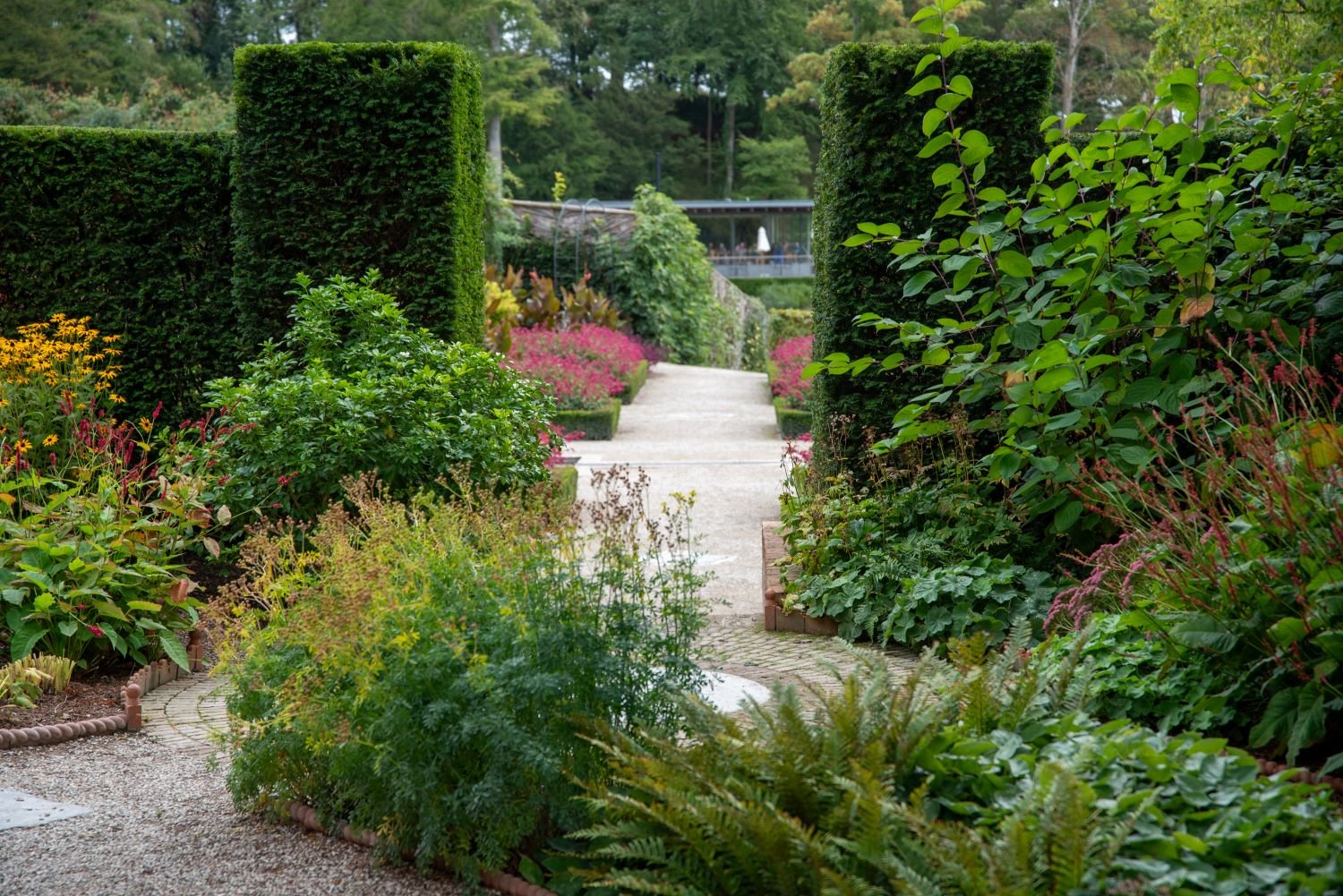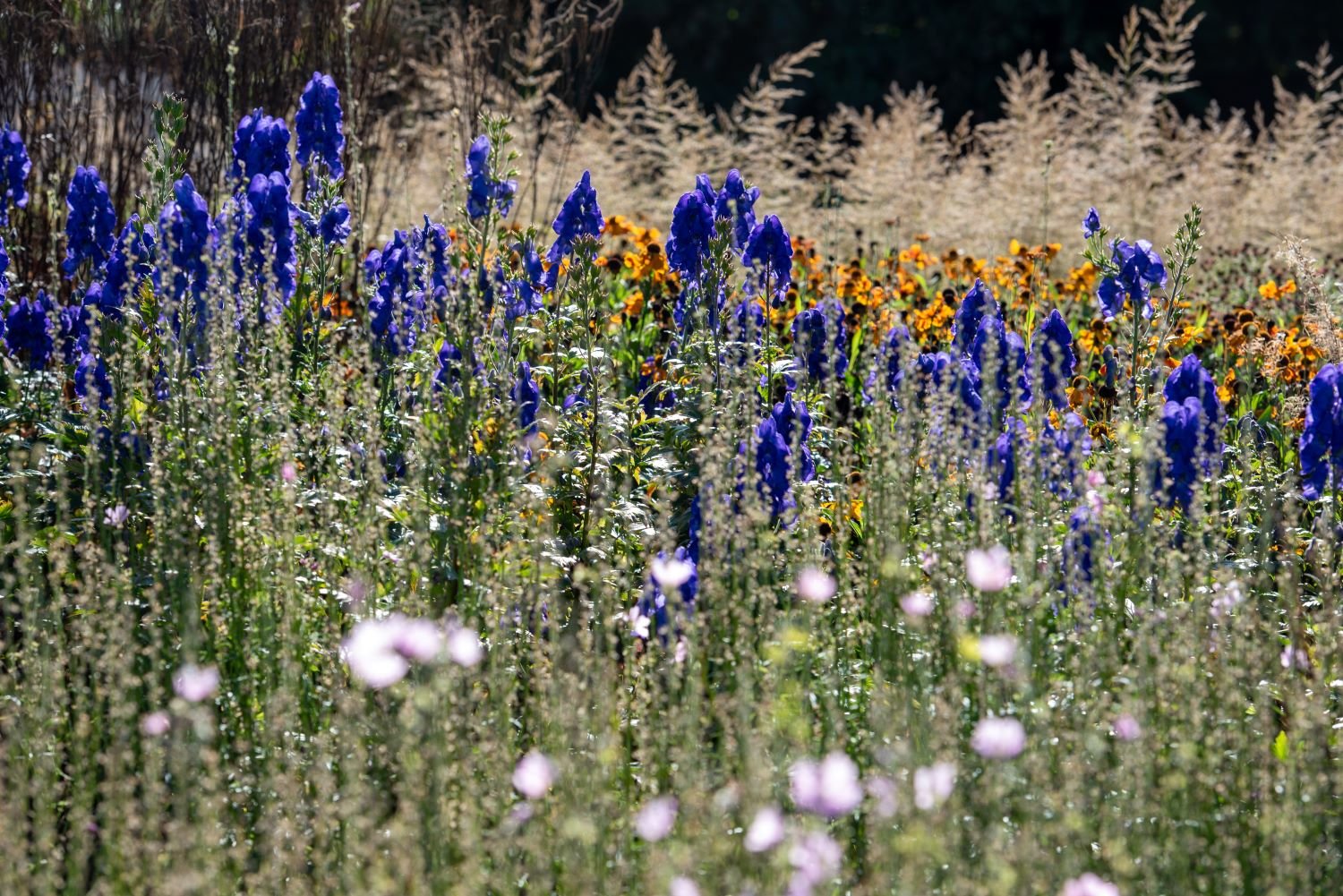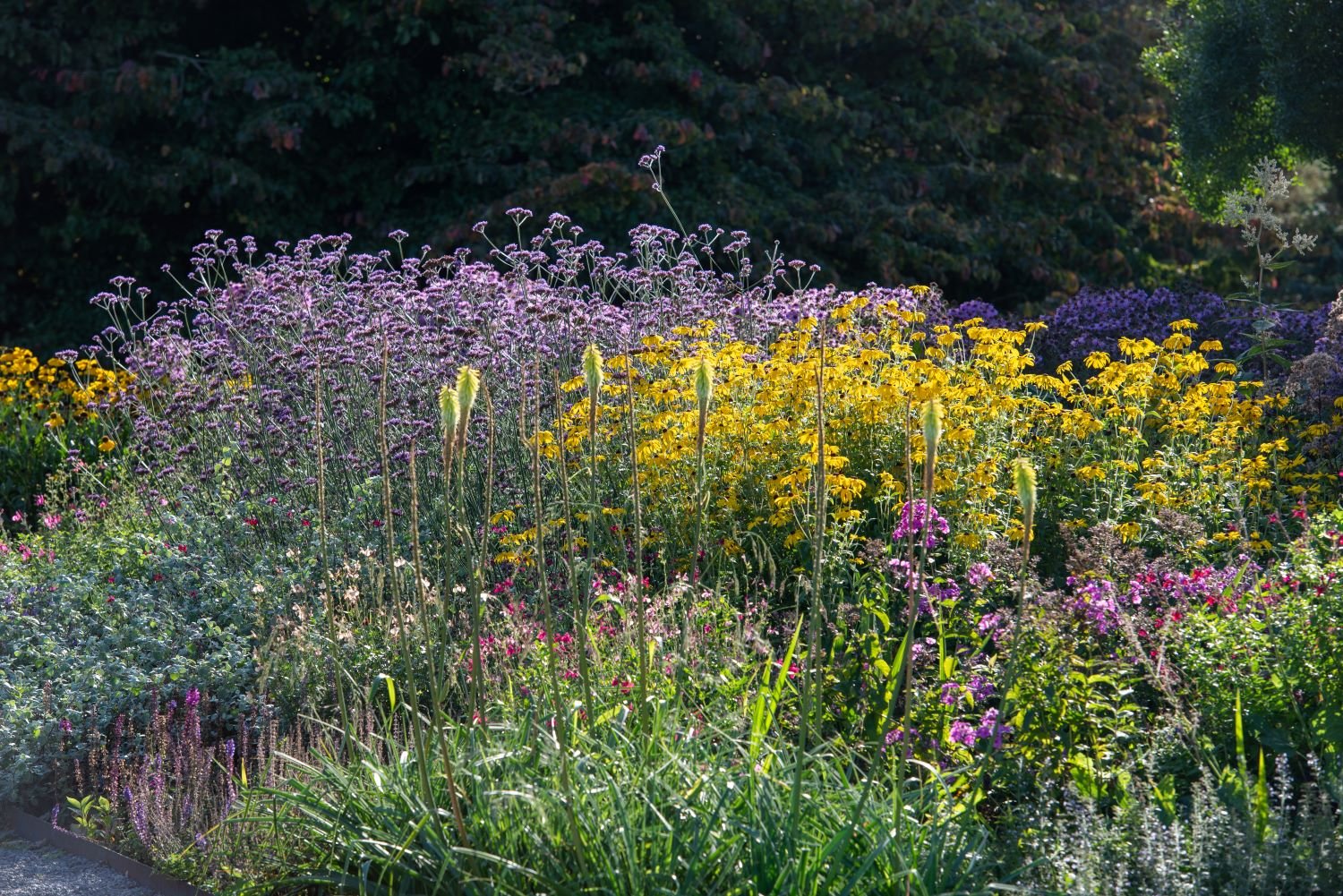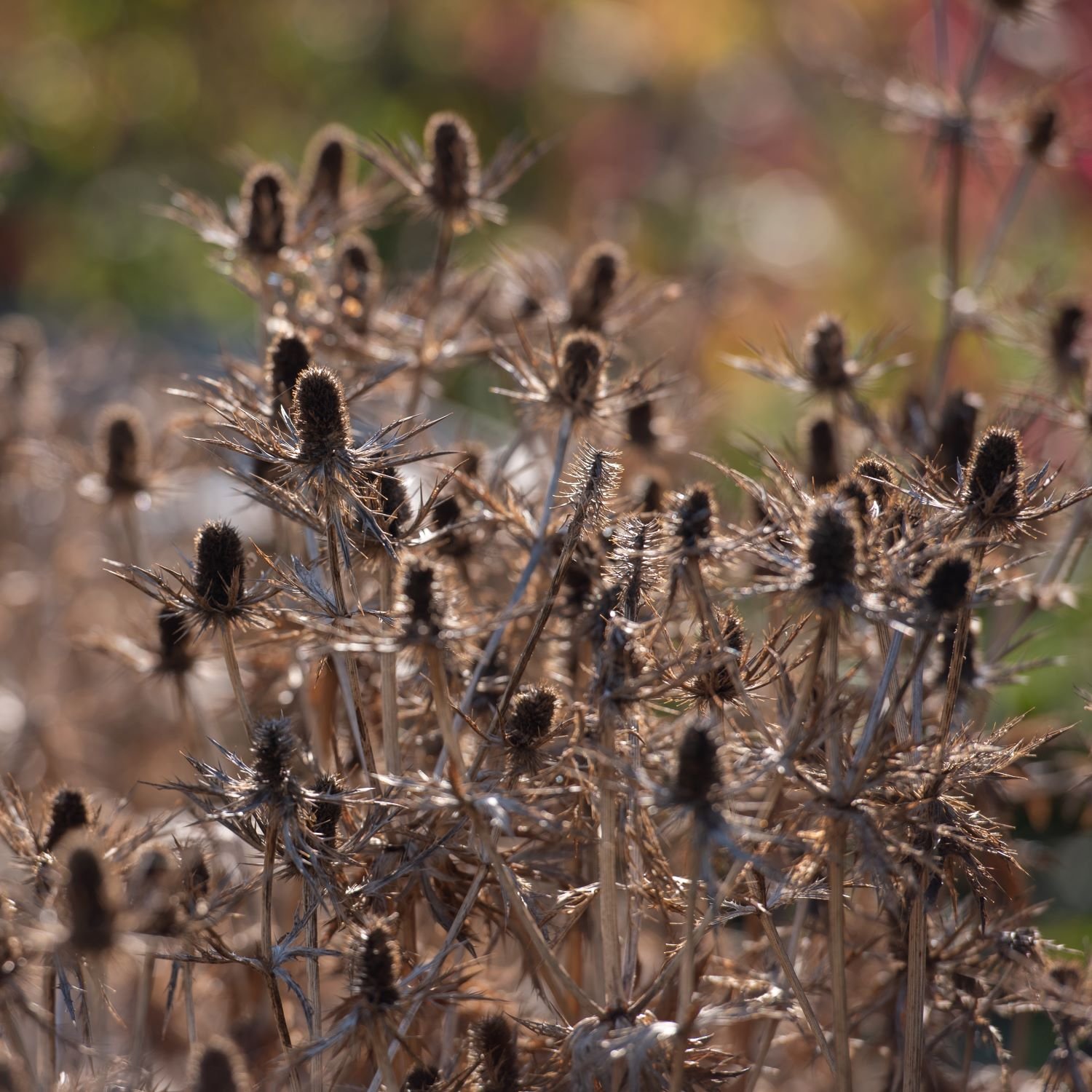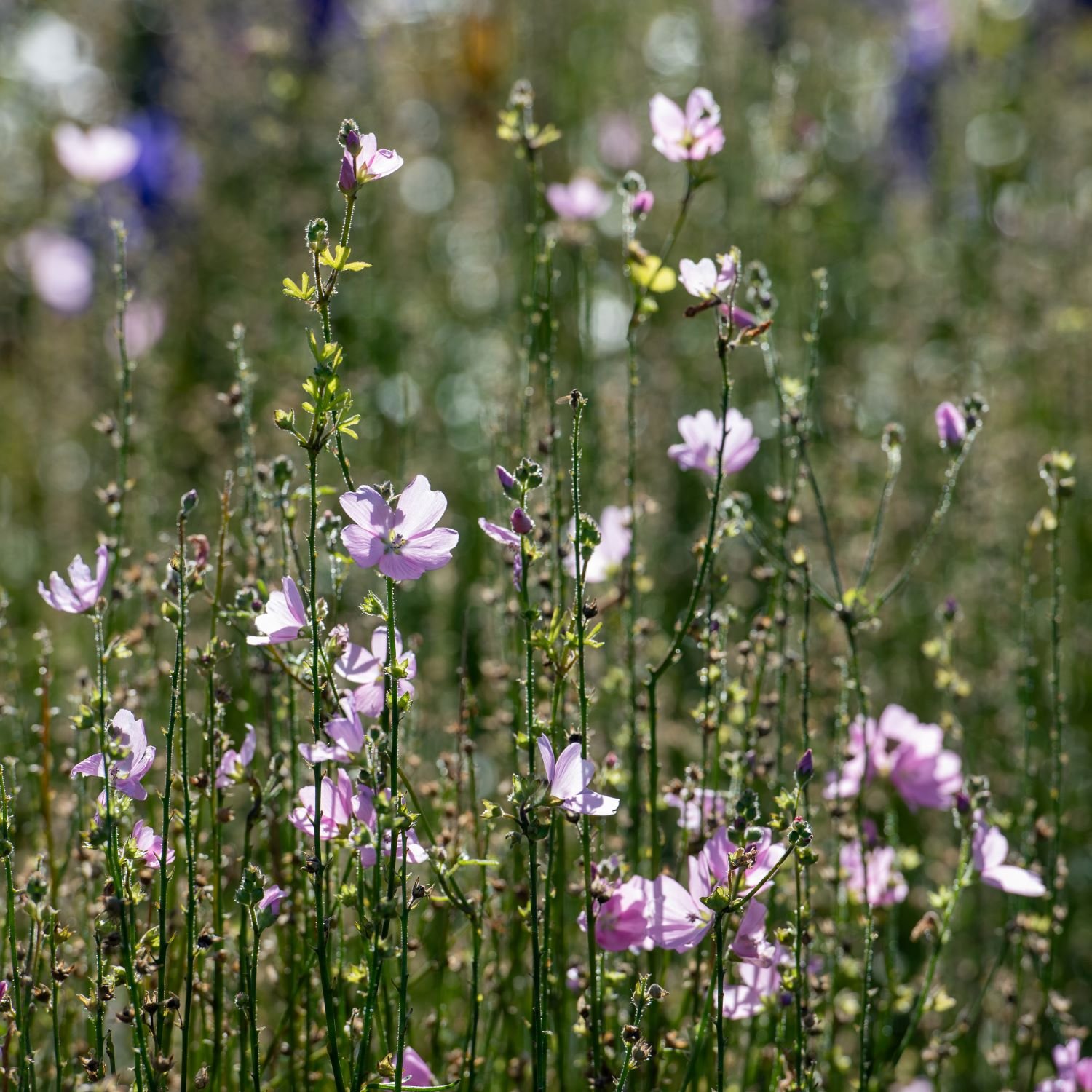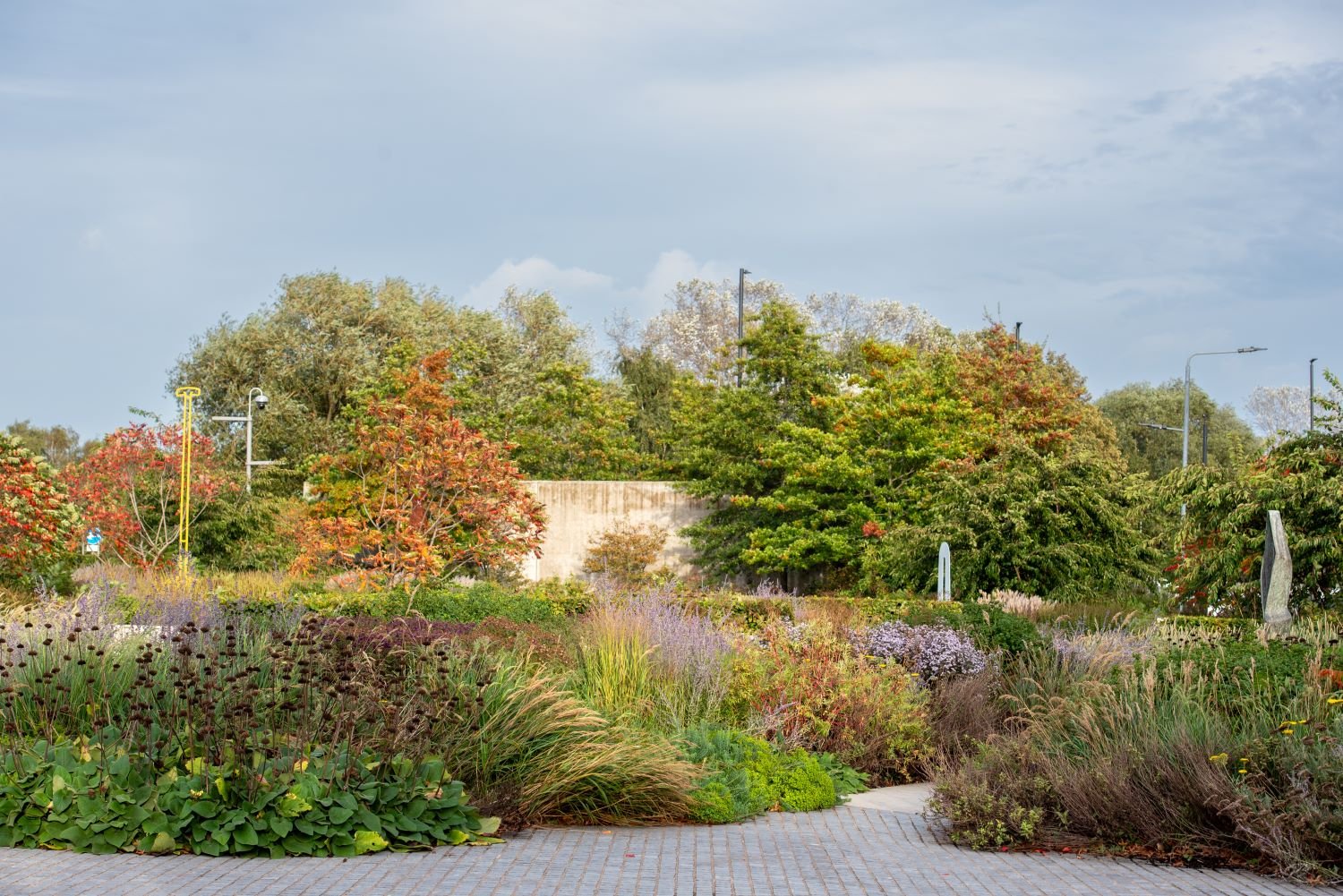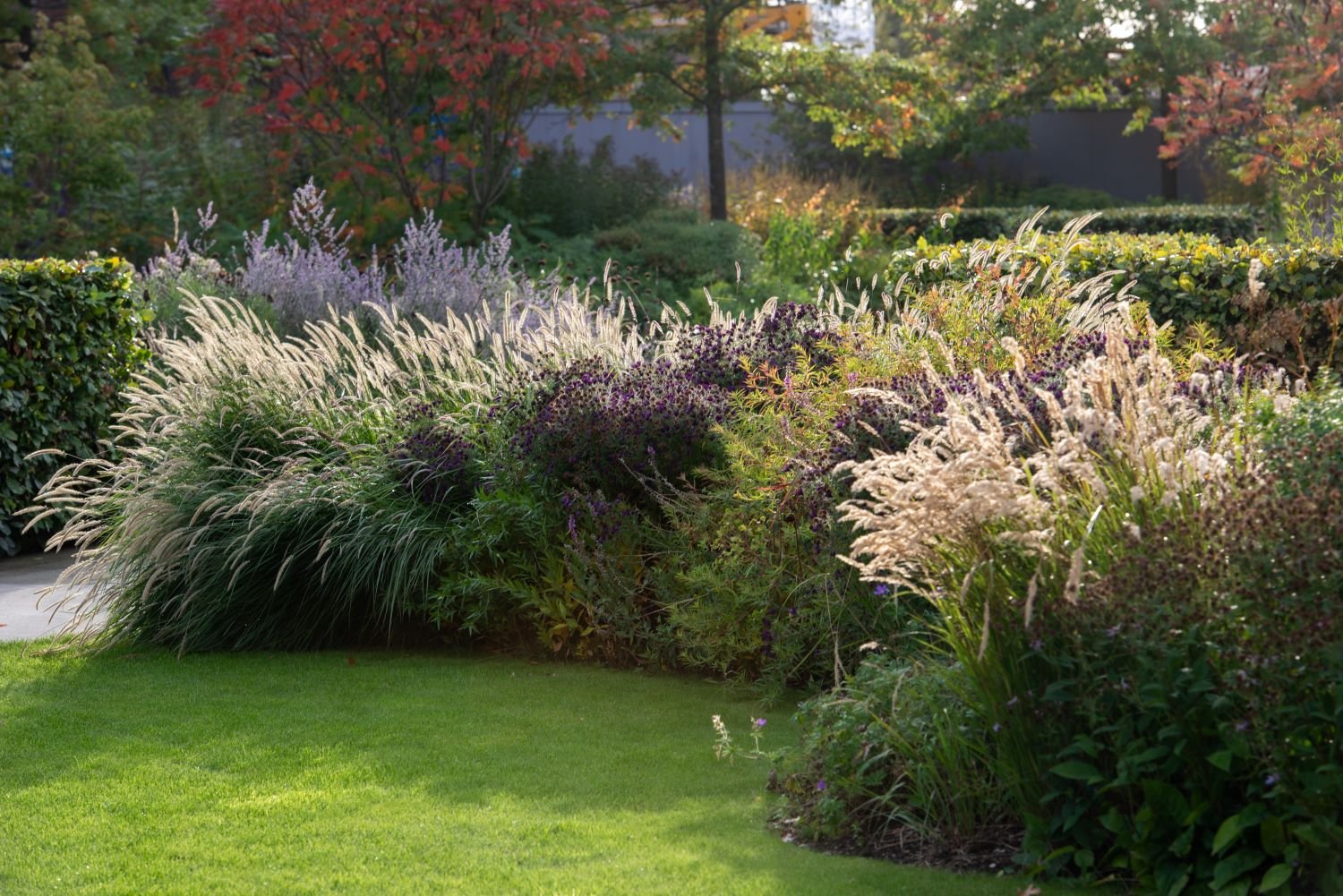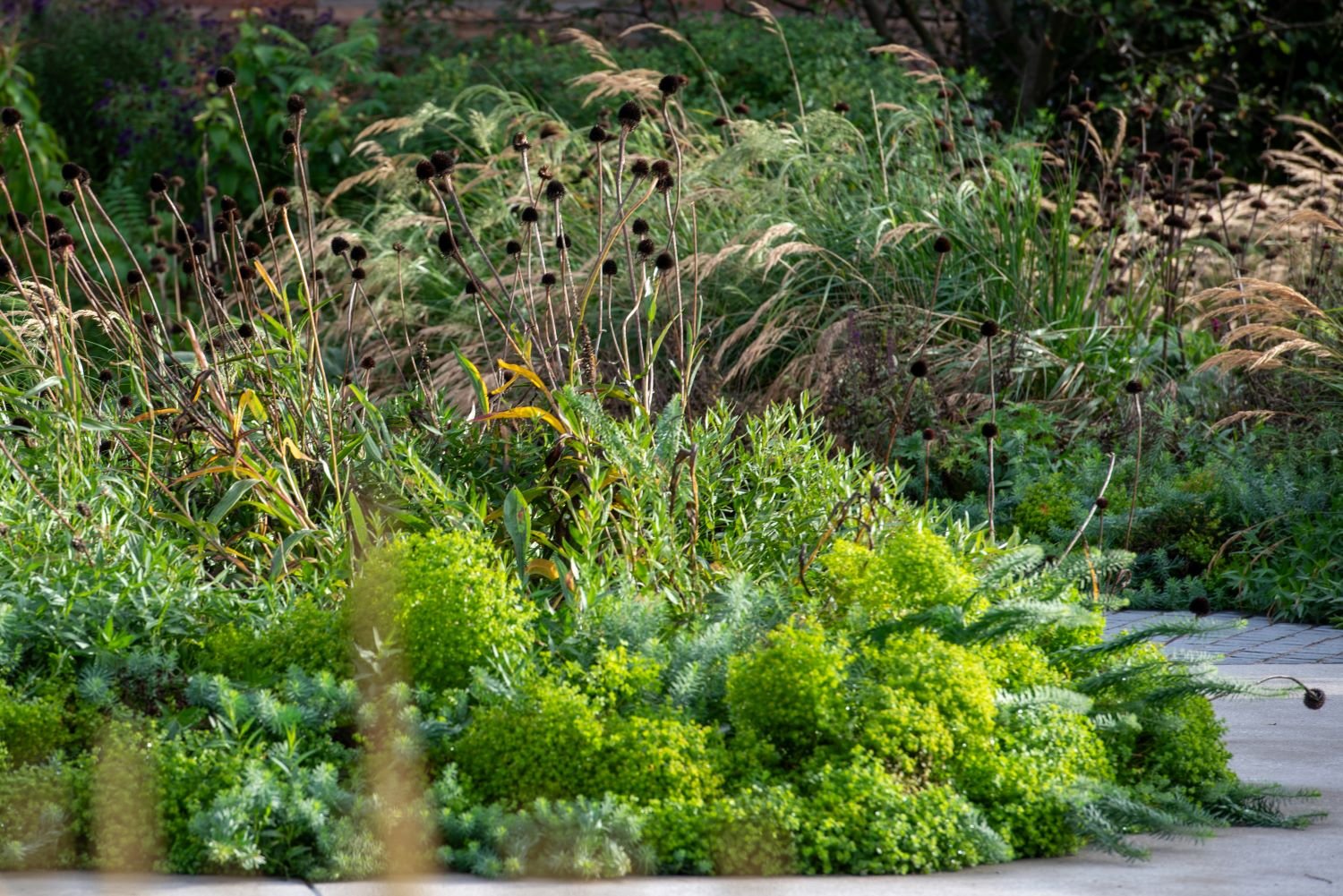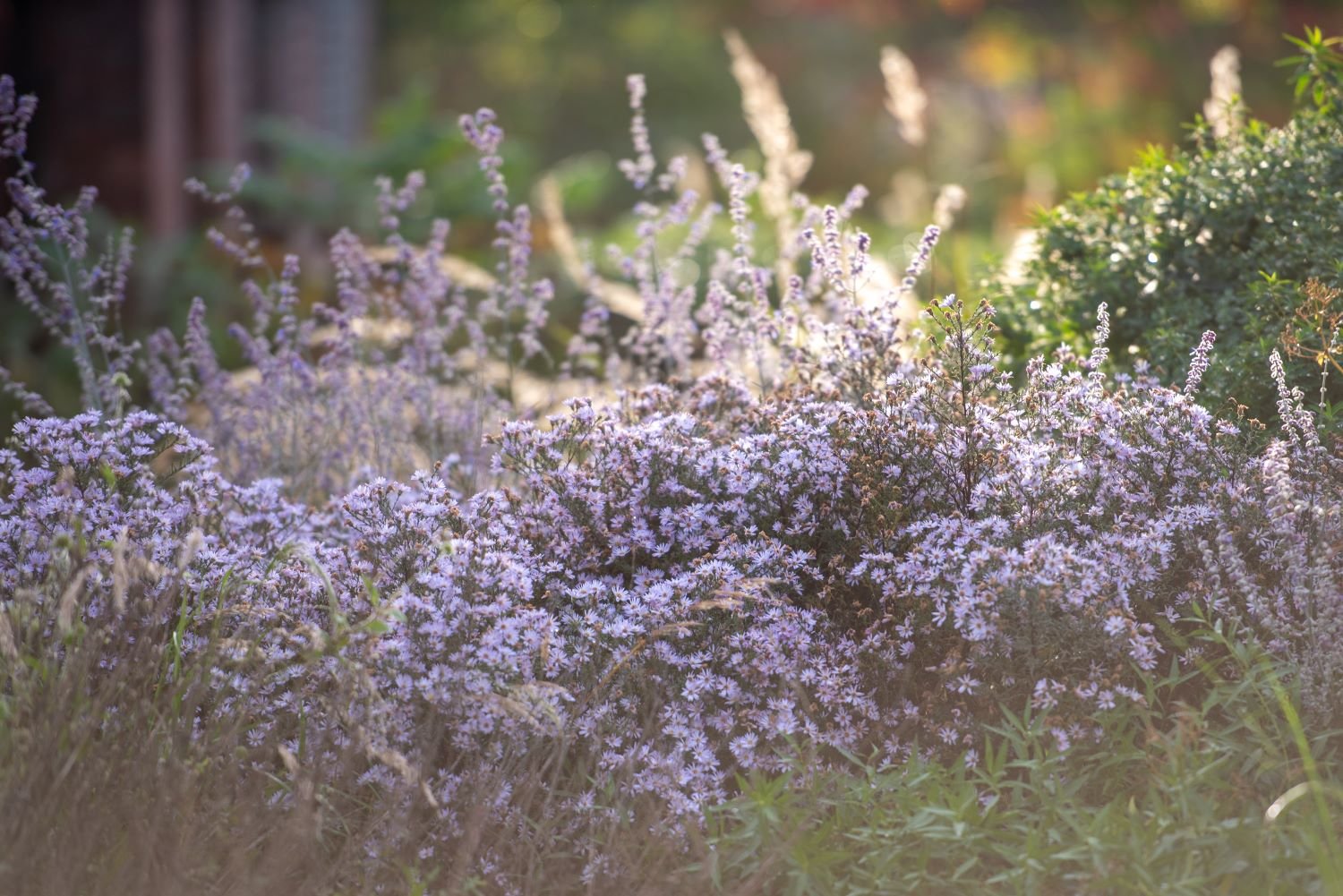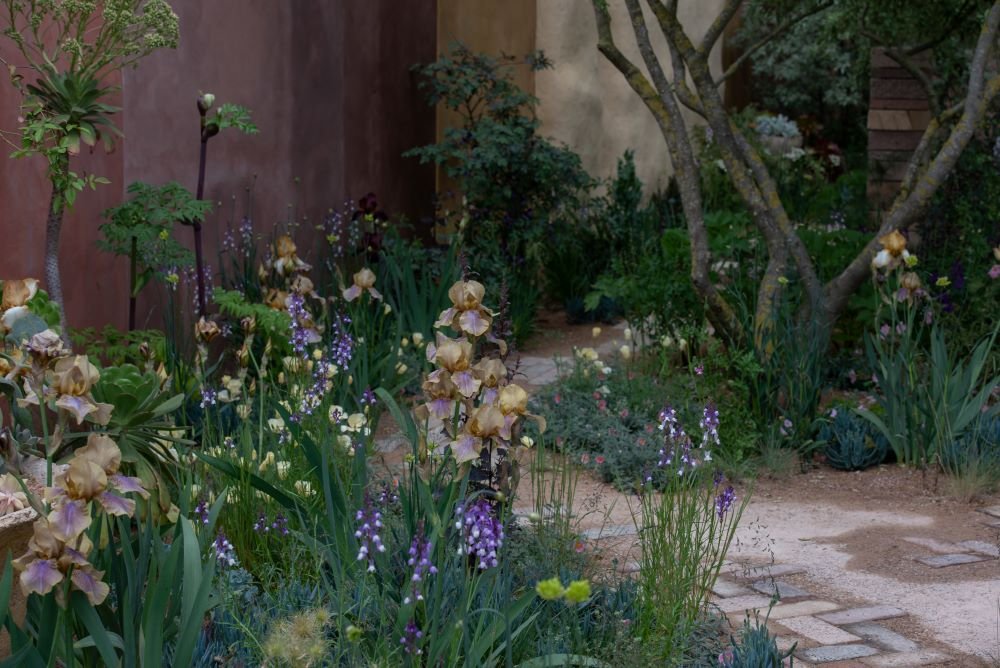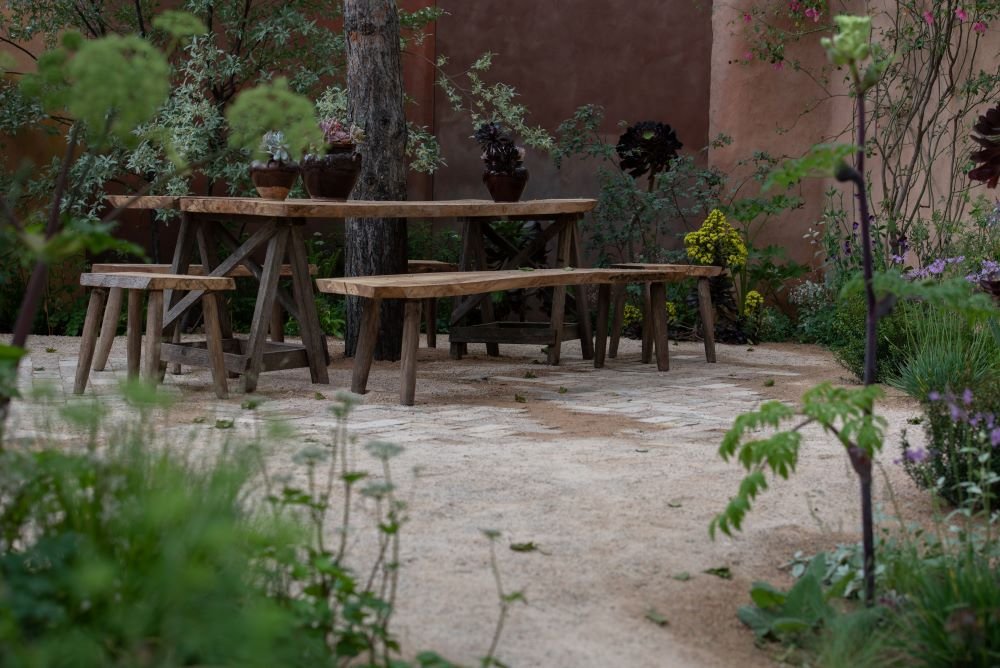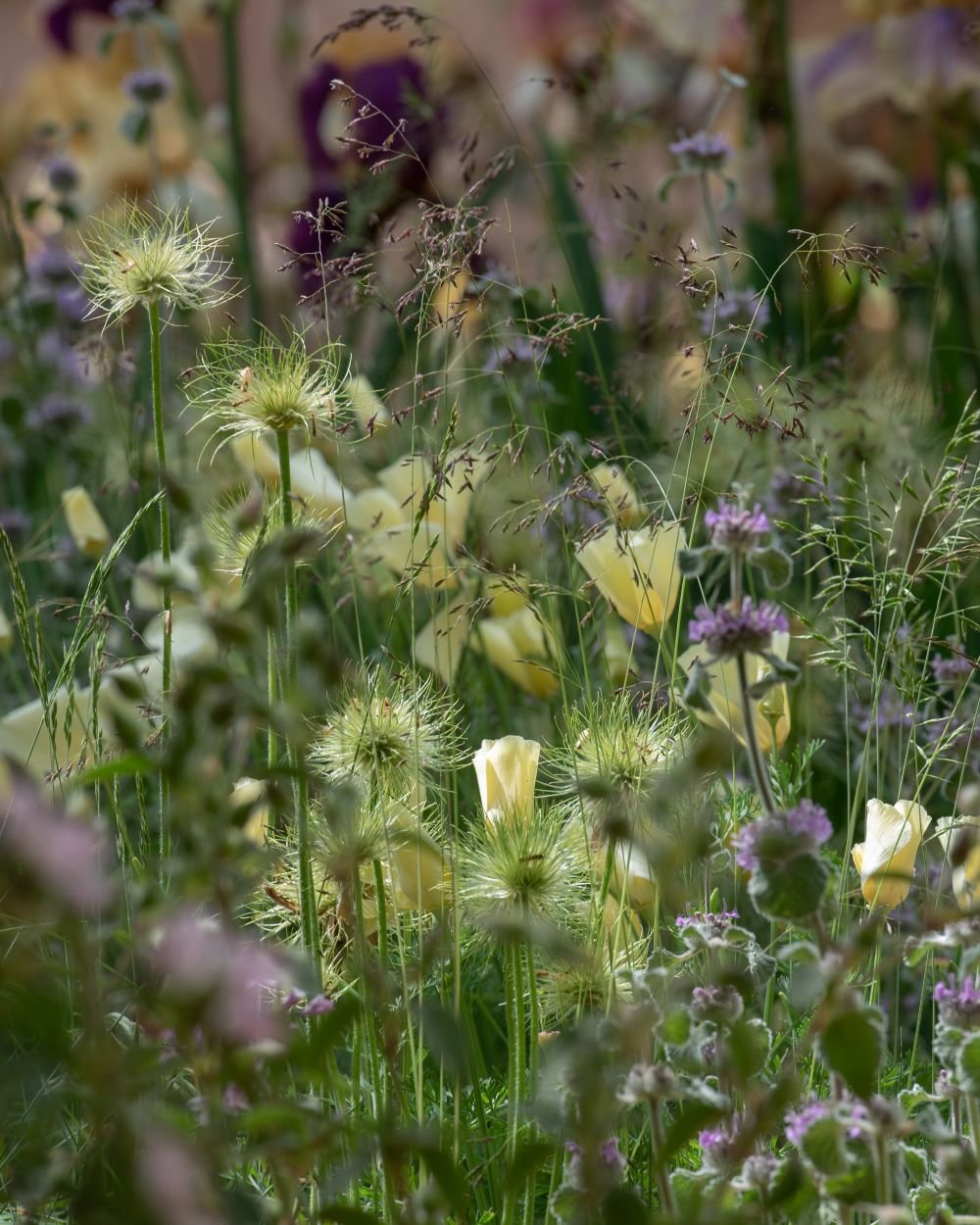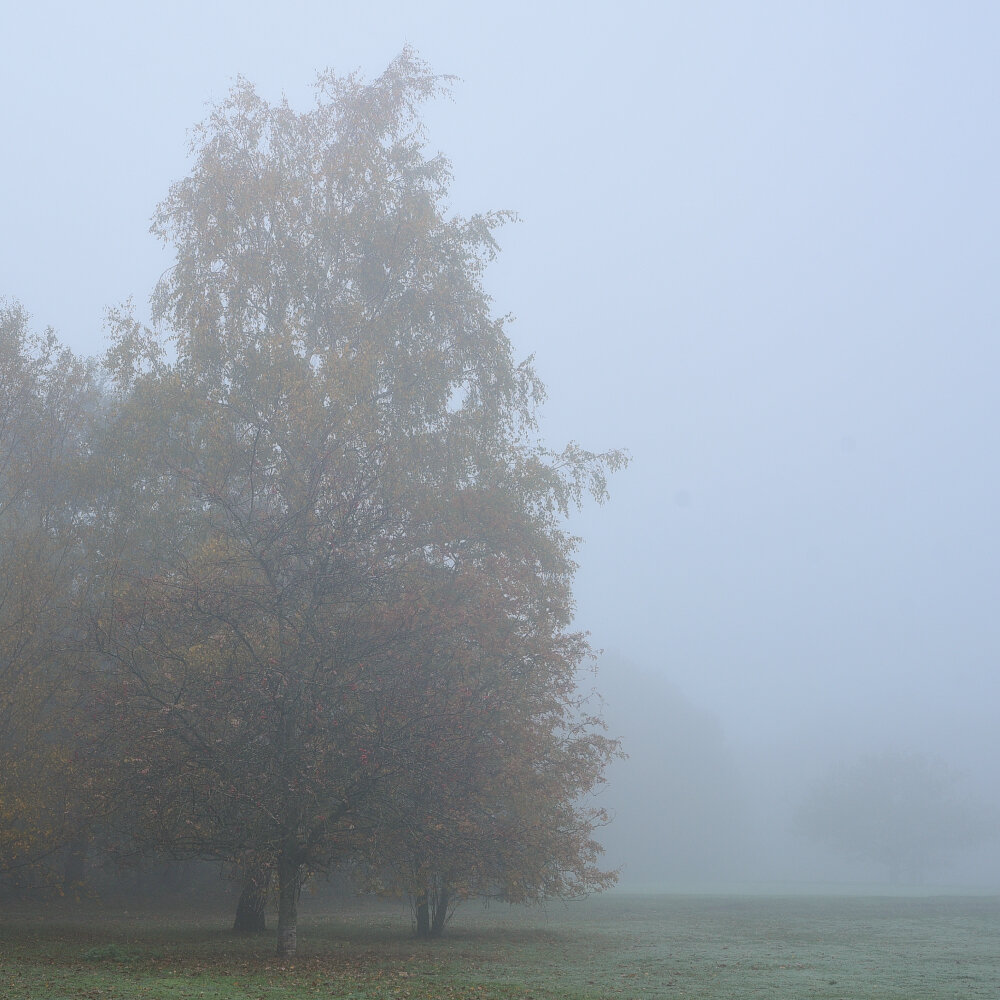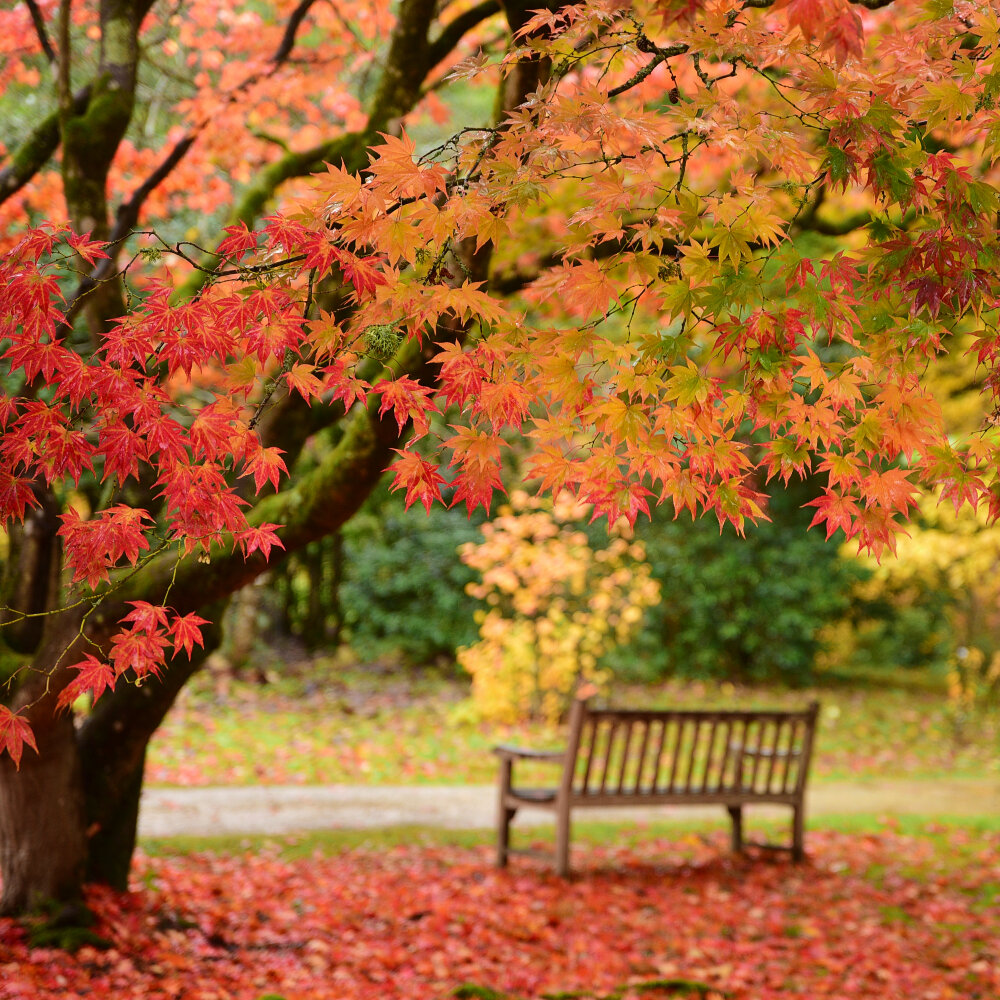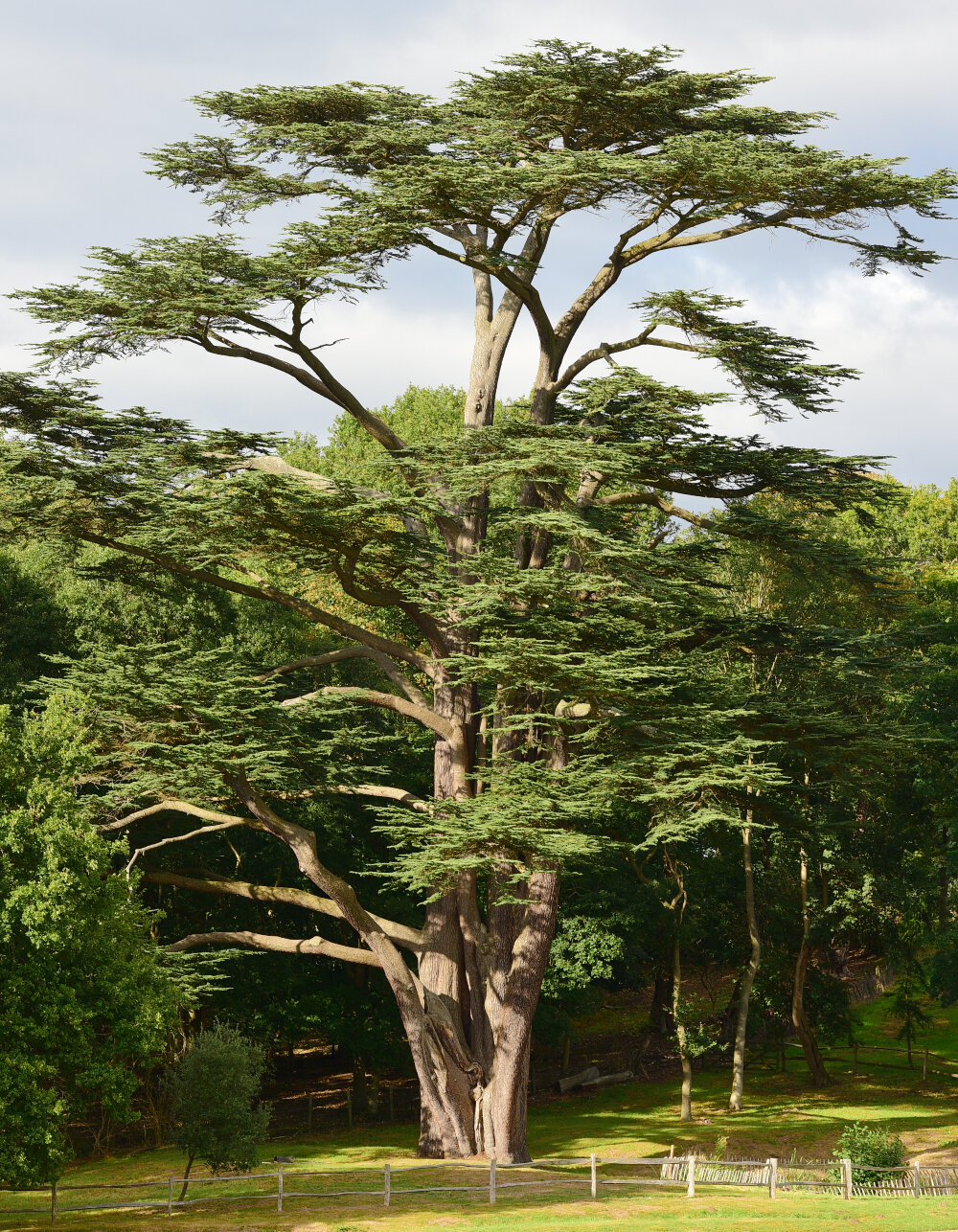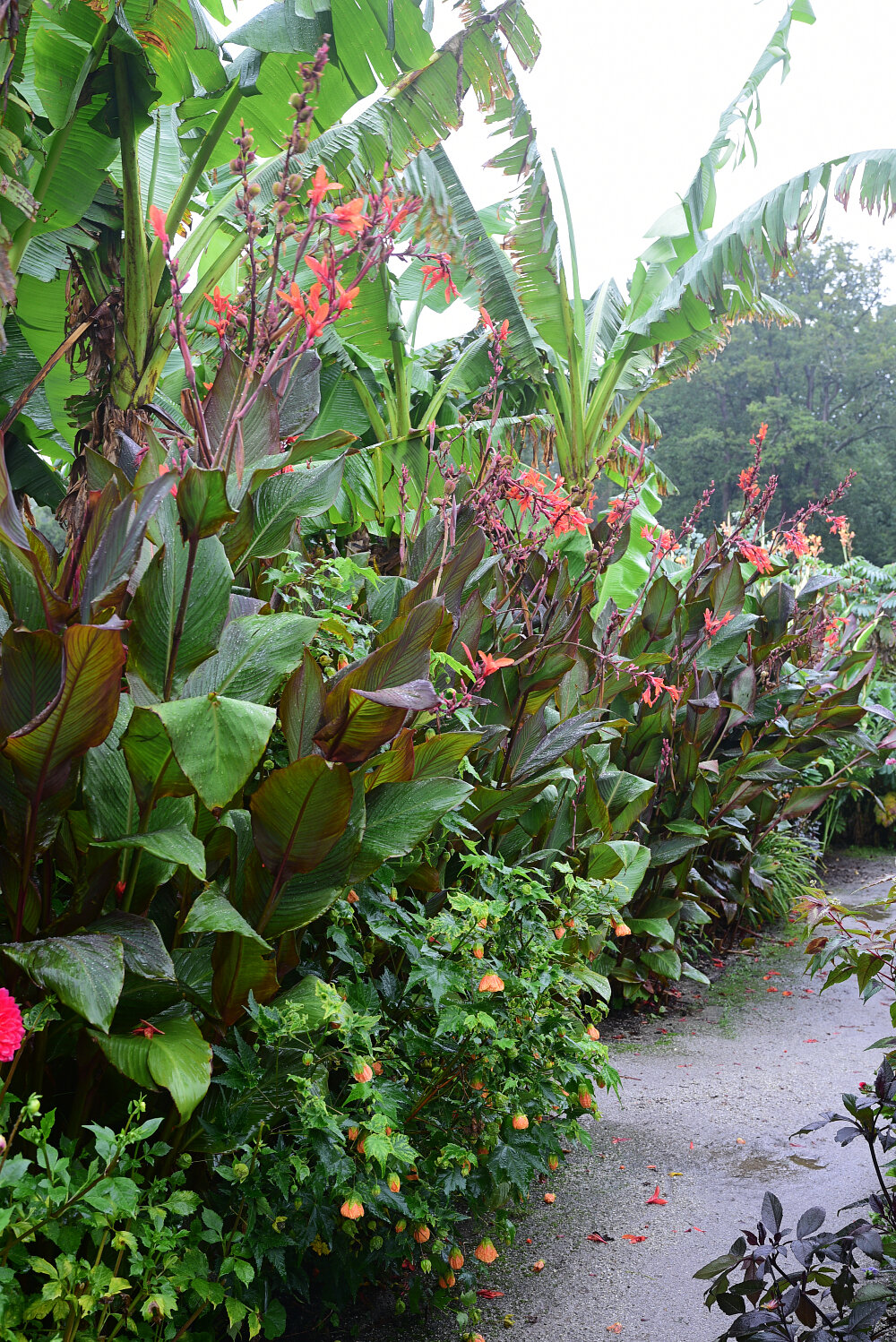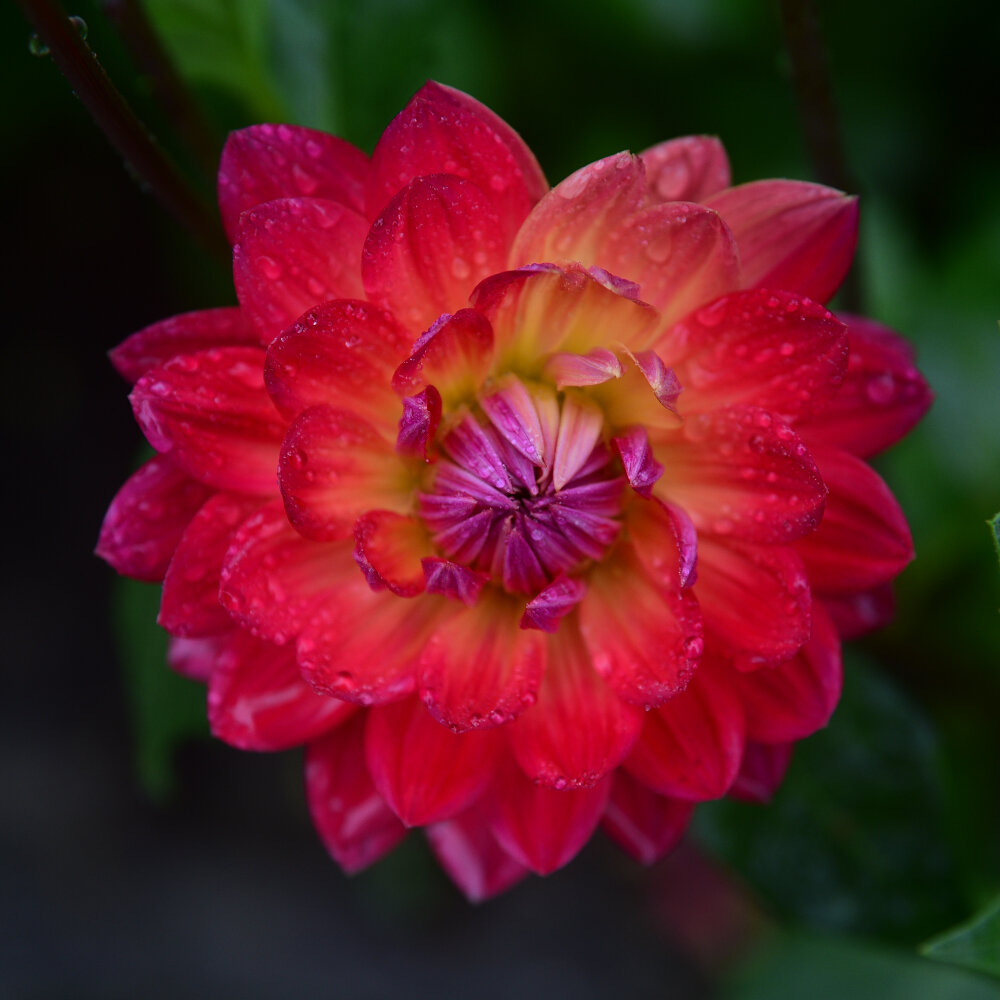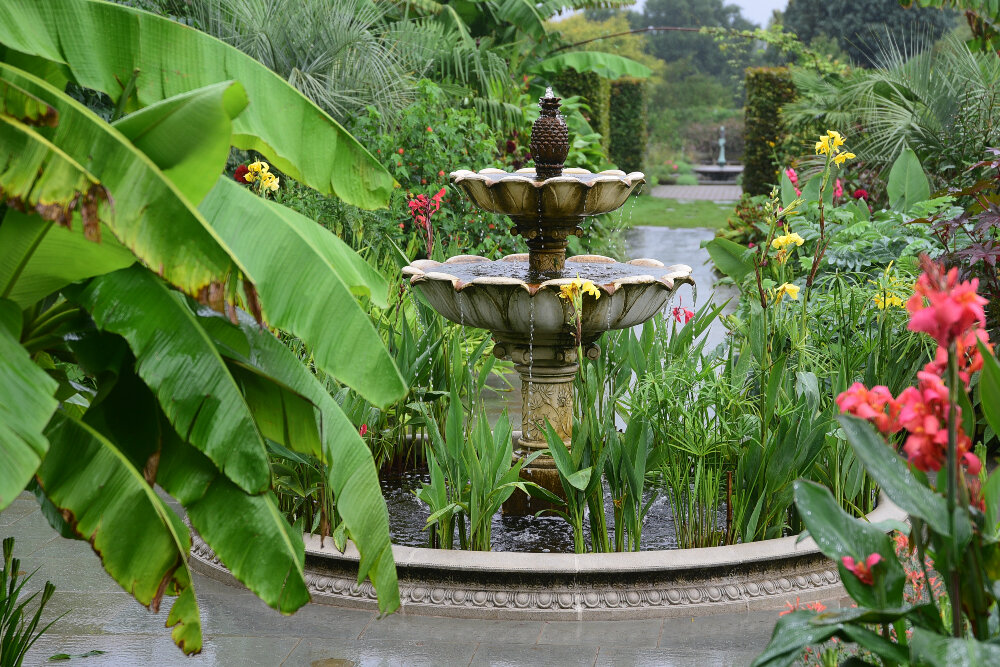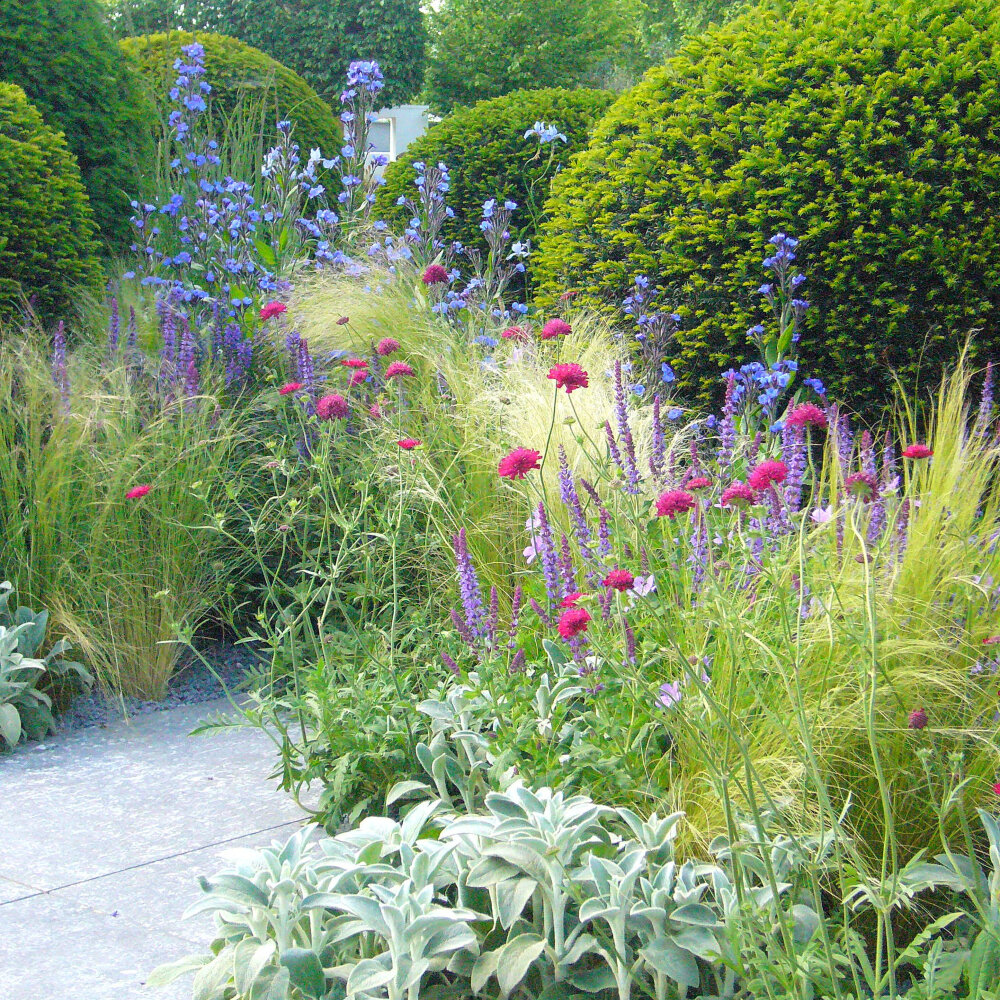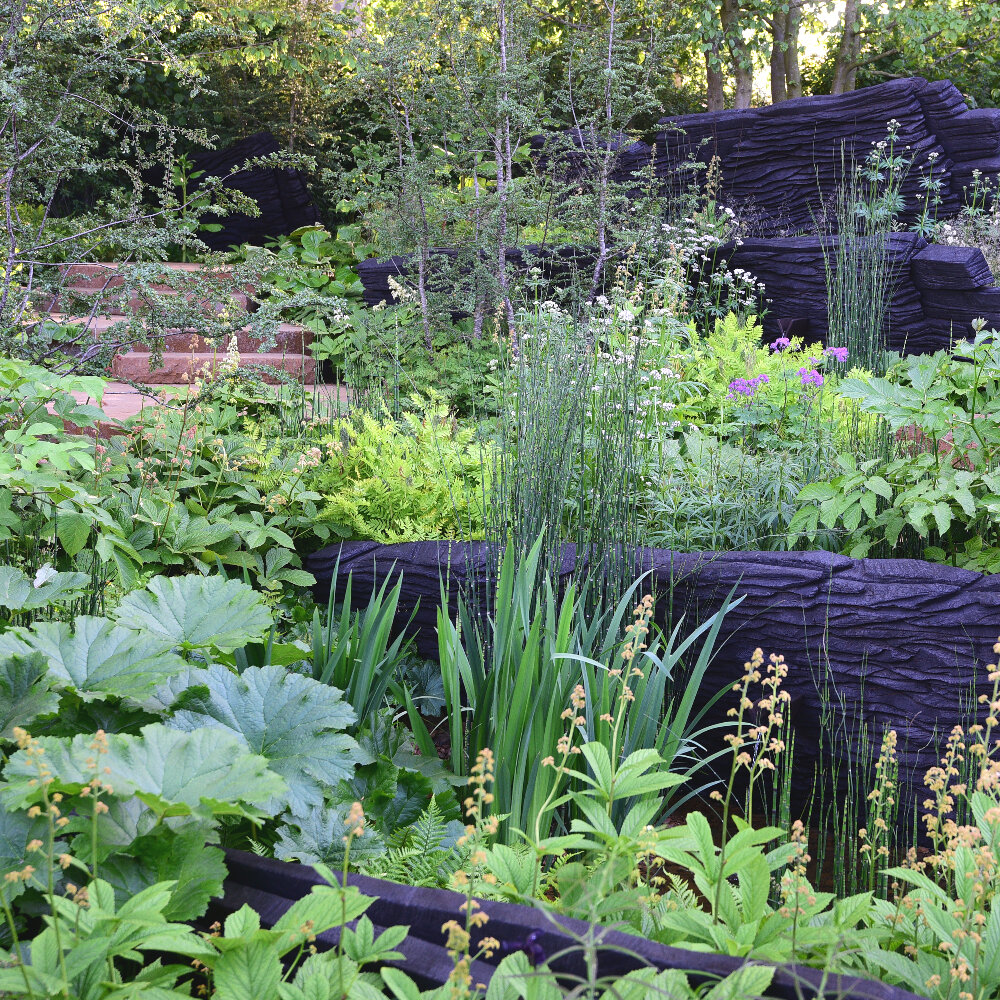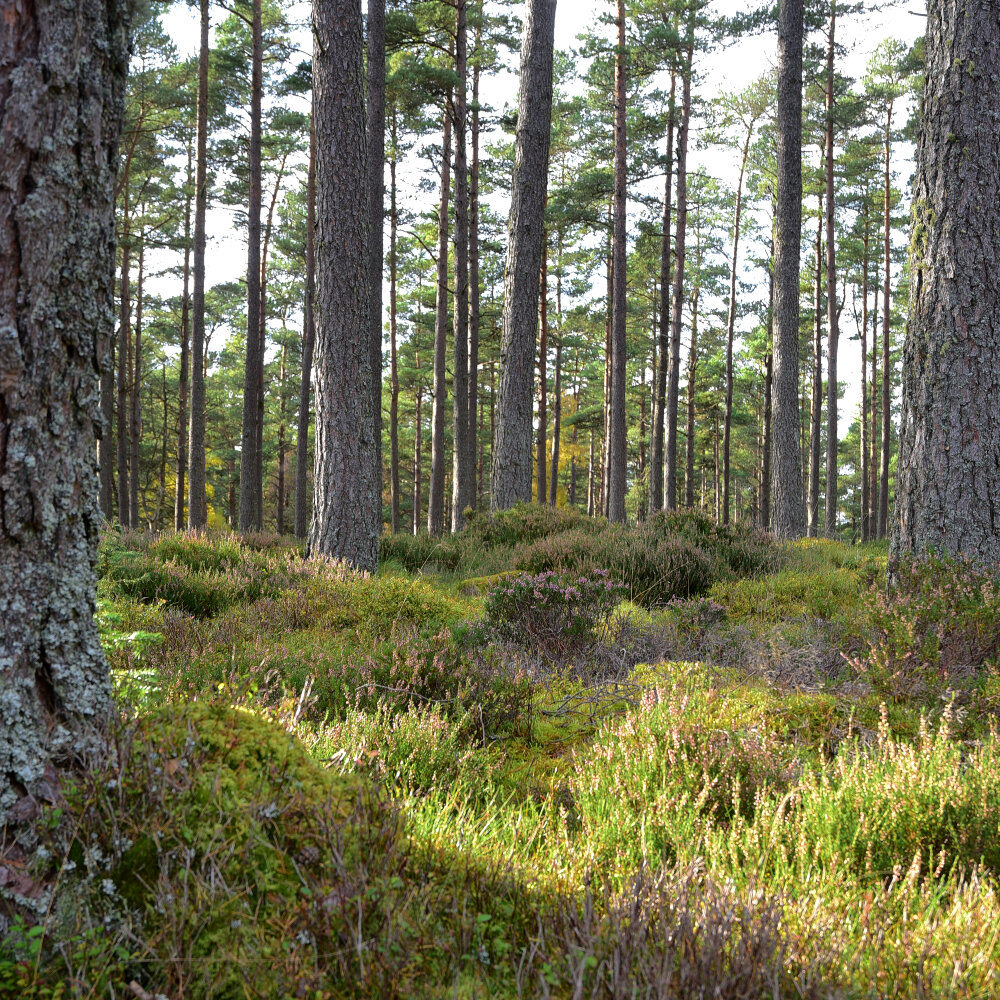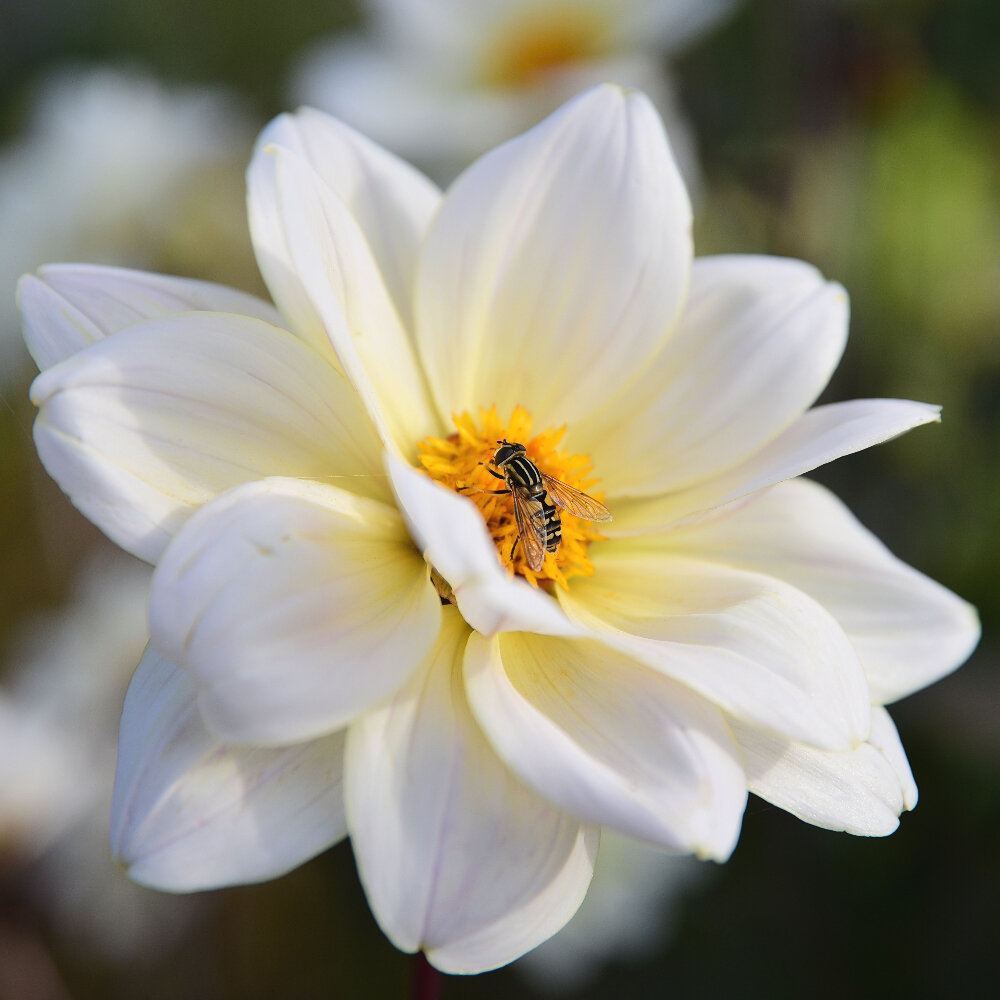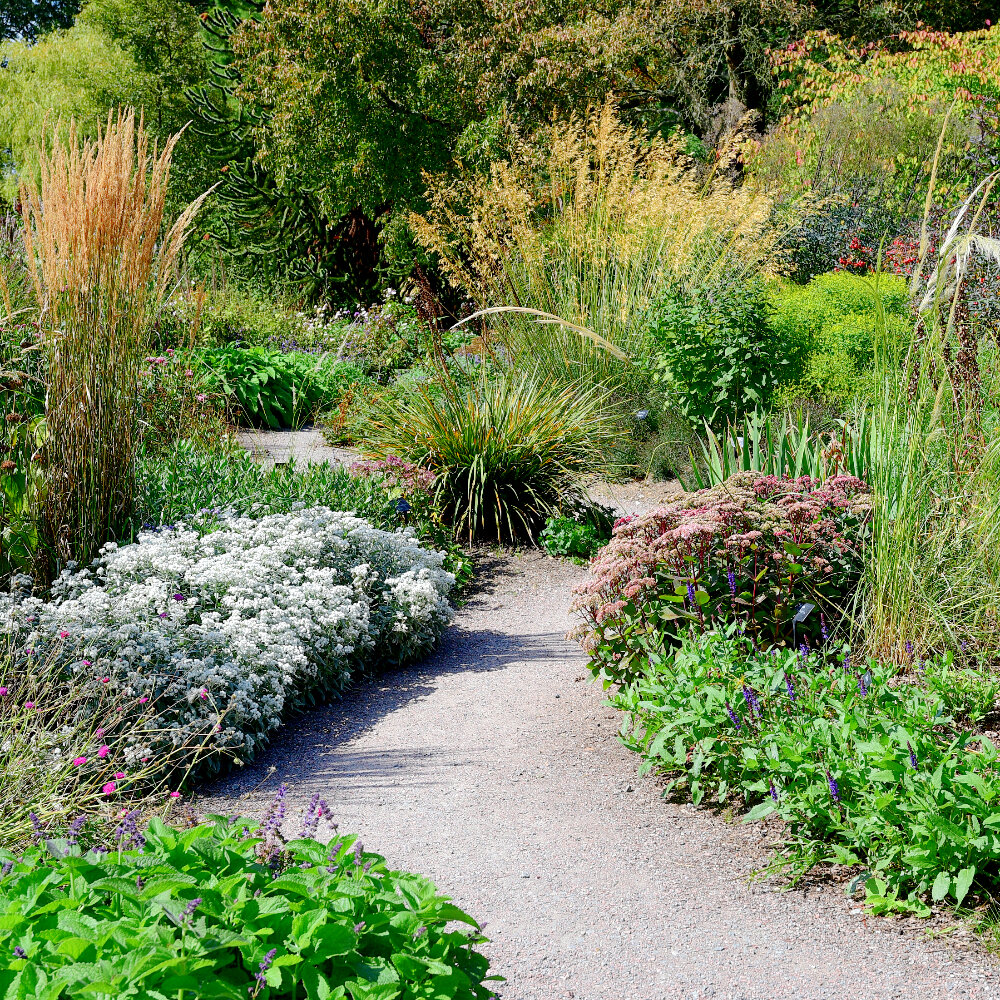Nymans
I think Nymans might be the first National Trust property I’ve been to where its all about the garden rather than the house. The garden is grade II listed, and the house is mostly a ruin.
View of the house from the South African bed
The 600 acre Nymans estate was bought by German emigre Ludwig Messel in 1879 and was occupied by his descendants, even after the devastating 1947 fire. It was handed over to the National Trust in 1953.
The summer borders
Unlike many houses devastated by fire this one has been left standing. It’s been cleverly planted with architectural and evergreen plants lending it the air of a gothic folly.
Architectural and evergreen exotic planting
If you go on the walking tour they will take you into a newly planted part of the great hall. It references Oliver Messel, the theatrical designer and Ludwig’s grandson, with corten screens and architectural planting, all in containers.
Tetrapanax, Cordyline and Wisteria
Yew topiary againt the house
The Forecourt Garden in front of the house is planted with topiary and naturalistic looking borders. In one corner is an attractive stone dovecote.
Achillea and scabious in the Forecourt Garden
Naturalistic planting in the Forecourt Garden
Topiary in the Forecourt Garden
The Dovecote
Ludwig Messell and his head gardener, James Comber, were avid plant collectors and breeders. The garden hosts many plants from the southern hemisphere, notably from Chile and Argentina. A large part of the garden is dedicated to plants from South Africa such as Dierama, Kniphofica, Berkheya, Watsonia and several Restios.
Berkheya and Dierama in the South African bed
The Rock Garden
The Rock Garden and lookout
The Rock Garden is a bit more rock star than your average 1970s effort, not least because of its scale. Aside from the expected heathers (many different varieties) but many Mediterranean plants like Santolina, Phlomis and the odd Trachycarpus thrown in for good measure.
The Rock Garden and Croquet Lawn
This is one of the very few National Trust gardens that I have really enjoyed. It is definitely worth another visit to see the Rose Garden, wildflower meadows, Wild Garden and the Wall Garden, all a bit earlier in the summer. The Pinetum is a really good example of its kind as well.
There are lots of opportunities for refreshments if you are not bringing your own picnic. I’d say it is one of the better NT cafes as well. Oh and there’s an excellent secondhand bookshop, definitely worth a look.
Le Chateau du Lude
On a short holiday in the Loire region of France I convinced myself there must still be a hidden gem of a garden that I hadn’t visited.
Le Chateua du Lude
Having done Villandry, Chaumont and Chenonceau I had to travel north to the banks of the other Loire valley river, Le Loir, and Le Chateau Du Lude.
Rose Garden
Le Lude is the most northerly château of the Loire Valley and has been inhabited by the same family for the last 260 years. The gardens have evolved to combine French design and an English-style landscape, with a rose garden, topiary, a labyrinth and a botanical walk. And an unpublicised organic kitchen garden.
Lower Garden
The lower garden running along the river, was the original vegetable garden. This was moved further away to create a romantic French-style garden designed by Edouard André a renowned landscaper in the 19th century. Parterres of flowers and ponds succeed each other, with scented flowering shrubs like chimonanthus, lilac, philadelphus and calycanthus along the wall.
The fields opposite were planted as a landscape park.
Lily pond in Lower Garden
The spring garden is full of early perennials but these were mostly over at the time of my visit in June.
Fountain in Lower Garden
Le Loir from under a copper beech
So far, so French. Not too much in the way of flowers or colour after the slightly past-it rose garden. And then I noted there was a kitchen garden.
The Kitchen Garden
It was midday as I arrived as the gardener was locking the gates to the obviously “prive” kitchen garden. Somewhat crestfallen I mustered a smattering of pidgin French to explain I was a garden designer and just wanted some photos. Eager to get to his lunch he opened the gate for me and asked me to lock it when I was finshed. I can’t imagine the National Trust doing that.
A mixture of flowers and fruit and weeds, well it is organic..
Fruit trees in the Kitchen Garden
Sisyrinchium striatum, phlox and California poppies
Orangery, used as a tool store
The Kitchen Garden was the most floriferous part of the gardens, the informality of the planting here is in stark contrast to the more formal areas elsewhere.
Birdbox in the kitchen garden
I would say the garden at Le Chateau du Lude wasn’t quite the hidden gem I was hoping for. Having said that I spent a pleasant couple of hours here. It’s not as busy as all the better known gardens in the Loire and I was grateful for that. There are no refreshments available so you’ll need to bring your own. And, of course, it’s not open at lunchtime…
Website https://www.lelude.com/en/
Project Giving Back - Chelsea 2024
In any other year a damp, grey day at the Chelsea Flower Show would have been unusual, not in 2024 though. Whilst most humans aren’t that happy in the rain, gardens absolutely love it. Colours are more vibrant and plants look much fresher.
The Octavia Hill Garden by Blue Diamond with the National Trust
In recent years there have been far fewer large show gardens on the main avenue, and now all are sponsored by charities rather than big corporates. This is in no small part as a result of Project Giving Back.
The WaterAid Garden
“Project Giving Back is the vision of two private individuals who want to support a wide range of charitable causes whose work suffered during the global Covid-19 pandemic and continues to be affected by the economic downturn and cost-of-living crisis.
World Child Cancer’s Nurturing Garden
The grant-making scheme gives UK-based charities and other charitable organisations the chance to apply for a fully-funded garden at the RHS Chelsea Flower Show, subject to the usual RHS selection process. This is a unique opportunity for charities to raise awareness of and support for their work at the world’s most famous horticultural event.”
Muscular Dystrophy Garden
The first Chelsea Flower Show to benefit was in 2022, and 12 gardens were supported. The most well-known of these was the best in show garden by Lulu Urquart and Adam Guinness - remember the controversial re-wilded garden for beavers?
The National Garden Scheme Garden
Most of the plants from this garden (there wasn’t a lot of hard landscaping) went to the Lindengate garden in Wendover, Buckinghamshire. This mental health charity uses its six acre garden to provide social and therapeutic horticulture to people of all ages.
Terrence Higgins Trust Bridge to 2030
A further 15 gardens were supported in 2023, including another best in show winner, Horatio’s Garden, designed by Charlotte Harris and Hugo Bugg.
St James’s Picadilly: Imagine the world to be different
Horatio’s Garden is a charity set up to provide gardens for people with spinal injuries and the show garden has gone to the Princess Royal Spinal Cord Injuries Centre in Sheffield, opening later this year.
The Anywhere Courtyard
In 2024 another 15 gardens were supported, including yet another best in show garden, the Muscular Dystrophy forest bathing garden designed by Ula Maria. This garden will be relocated to The Prince & Princess of Wales Hospice in Glasgow.
mgr Changing Tides Garden
It’s quite a complicated process moving a show garden to its final home. Inevitably there is an element of redesign to fit the new space and in the meantime both the hard landscaping materials and plants may have to be stored before they can be re-used. Some new elements may be incorporated as Chelsea Show gardens are for May, not really for 12 months of the year.
Stroke Association’s Garden for Recovery
Project Giving Back is scheduled to continue for a further two years. It’s a good fit with the RHS’s ethos of sustainability and trying to keep the Chelsea Flower Show as green as possible.
Sue Ryder Grief Kind Garden
Project Giving Back also provides support for garden designers, helping those with a good idea find a charitable partner to link up with, and it also helps newer designers get into Chelsea for the first time.
Bowel Research UK Microbiome Garden
All good things usually come to an end though, so how will the RHS find sponsors with pockets deep enough for a £250,000 show garden once Project Giving Back ends after 2026?
Isabella Plantation
It’s very easy to visit Richmond Park regularly and completely miss the Isabella Plantation. The deer are kept out of this part of the park, allowing for a wide variety of trees and a more garden-like feel.
Principally a woodland garden, it is in spring that the many flowering shrubs and trees come to the fore. There are witch-hazels, camellias and magnolias in early spring. In April and May it is the turn of azaleas and rhododendrons. Get ready for a technicolour tour.
The garden is home to the National Plant Collection of Wilson 50 Kurume Azaleas, introduced to the west from Japan in the 1920's by the plant collector Ernest Wilson. If you want to identify them all this website has the definitive list.
The Isabella Plantation sits in a natural dip and running and still water throughout is a major feature.
Most of the water features are man-made, water is pumped from Pen Ponds and the streams were dug out in the 20th century. The lower part of the Plantation is naturally boggy and the garden plants here reflect that with asiatic primulas, gunnera and this rather fantastic Darmera peltata.
Isabella Plantation has been subject to some significant investment in recent years. Ponds have been cleared of silt, the remaining invasive Rhododendron ponticum has been cleared out, along with rampant skunk cabbage. And the paths and loos have been upgraded. If you’ve got a blue badge you can park very close by and all the paths are acessible with a wheelchair. Dogs on leads are allowed.
Most people know that I’m not a big fan of rhododendrons, particularly in smaller gardens. Where they’ve got space to do their thing though they look majestic. I like seeing them in dark groves where they can look moody and mysterious, particularly on a gloomy day.
And just occasionally you come across some very delicate flowers, completely different. Unfortunately I cannot find the name of this one.
2023, a year in photos
I googled “what will 2023 be famous for?” There were some forecasts - war, climate catastrophe, financial turbulence and technological change - so far, so predictable. But a fashion trend for blackened teeth thankfully hasn’t come to pass (or did I miss it?).
Wimbledon Common in January
The year started with a famously cold January. It was a near record of eight days in a row of freezing temperatures. Whilst Wimbledon Common looked fab in the heavy frost the weather took its toll in the garden. Many people lost plants, in particular Hebes, Erigeron karvinskianus and Penstemons. They were hard to replace initially as the frost had affected so many gardens as well as suppliers in the UK and Europe.
Cyclamen at Wakehurst Place in February
One answer to this is to plant a winter garden, full of plants that look their best at this time of year. I went to visit Wakehurst Place which has a fairly new winter garden. It didn’t disappoint and partly as a response to this we have developed a couple of winter borders in my local park.
Magnificent magnolia in Bushy Park in March
A persistent easterly wind in March and April meant that spring felt like a long time coming but finally, after a few false starts, I got on a plane for the first time in three years to go to the garden island of Madeira.
Fanal Forest, Madeira, in April
There were gardens aplenty on the island but one of the most fascinating sights was the ancient laurel forest on the north slope. Subject to frequent fog and mist the trees were already mature when the Spanish arrived in the 14th century. It is an eerie place and, as I found, it’s very easy to get lost.
Bluebells in the Surrey Hills in May
May was a busy month. The weather warmed up a little and I found a great new bluebell wood in the Surrey Hills. The sun also came out for the Chelsea Flower Show and there was only one garden everyone was talking about - Sarah Price’s iris garden. It wasn’t overrated, almost worth the ticket price on its own.
Chelsea Flower Show in May
Also in May I finished planting a new garden in Wimbledon. Throughout the year I have continued as a volunteer gardener in my local park. Luckily the summer wasn’t quite as scorching as 2022. The ox-eye daisies in a wildflower part of the park were stunning in June.
Ox-eye daisies in June
All through 2023 I have been learning how to use a 3D design software package. It has been challenging to say the least but considerable progress has been made. I’m not sure I’ll ever reach guru status, but it’s good to get to a stage where clients can see their prospective gardens in 3D and even walk through them. I haven’t had a client yet say they prefer the old hand-drawn way of doing things.
Cedar greenhouse in July
In July I caught up with a friend who I’d helped with the layout of her garden ahead of the installation of a new greenhouse.
Waterperry Gardens in August
In August there was an overload of garden visits to Ham House, Waterperry Gardens and the best garden I’ve seen in a long time, Le Jardin Plume.
Le Jardin Plume, Normandy in August
Whilst in France I also visited the garden festival at Chaumont and the formal gardens at Chenonceau.
Chenonceau in September
Autumn took a long time to arrive, an unexpected heatwave followed by what seemed like endless rain, and then finally, some spectacular colour. Piet Oudolf describes a fifth season, somewhere between summer and autumn. The garden at the Hepworth Wakefield is a great example of how good a garden can look at this inbetween time.
Allium sphareocephalon and Perovskia in October
And my photographic year ends there, somewhat abruptly. The big camera is out of action and the camera on my phone doesn’t really cut it as a replacement. Normal service will be resumed shortly, hopefully in time for some winter photography.
Gifts for gardeners
It’s back, the only reasonably sensible list for gardeners of all types, no cashmere pyjamas or pink suede gauntlets here…
These are two of my favourite coffee table purchases of the year. I enjoyed my visit to Le Jardin Plume so much I bought the book. Yes it is in French but you don’t need to be fluent to get the gist of what’s going on. The photos tell the story, and the photos are fab.
I’ve been going to Kew Gardens since I was knee high to a grasshopper but only went into the Marianne North Gallery for the first time earlier this year. All of the 627 paintings - part botanical illustration, part travelogue - are reproduced here. Marianne North visited 13 countries and four continents in the second half of the 19th century and she paid for the construction of the gallery to house all her paintings. A major vanity project? And so what.
Sarah Price’s garden at the 2023 Chelsea Flower Show
Well no list is complete without a ticket to the Chelsea Flower Show. Is it expensive, is it over crowded, is it worth it? Hell yeah. The RHS runs one or two other shows which are all a bit cheaper, a bit less less busy and, well, you get what you pay for….
Looking for an easy way to boost your garden’s attractiveness to wildlife? Just add water. Birds, insects and mammals will all find a small pond very appealing. It doesn’t have to be deep, or have a fountain or even require digging a big hole.
A shallow water bowl or bird bath will do the job. A few pebbles and a couple of plants will finish it off nicely.
West Green House gardens and caff
Who doesn’t enjoy a nice garden visit with a fabulous lunch thrown in? Top of my list is Gravetye Manor (still waiting..), The Newt was fab and the cafe at West Green is a little more modest but no less tasty.
The restaurant at The Newt
Most gardeners are suckers for tools, especially really good quality ones. I’ve mentioned Felco secateurs before, as well as Showa 370 gardening gloves, Silky Fox folding saws, Hayter lawnmowers and Henchmen ladders.
Fab even when not in use
And they also love seed trays, garden twine, small terracotta pots, compost (but so awkward to wrap…), magazine subscriptions, bird boxes, seeds and cake of course.
Cedar greenhouse
But nothing says I love you like a bespoke cedar greenhouse…
And finally, what not to buy a gardener unless they have specifically asked for it - a plant. You have no idea how difficult it is to accommodate a rose that’s the wrong colour, or an inappropriately sized tree, into a carefully curated garden.
RHS Harlow Carr
A visit to Yorkshire to see friends meant a long-awaited trip to the RHS garden at Harlow Carr.
Harlow Carr
It’s a much more compact garden than Wisley, making it much easier to get around and see almost all of it. The garden was looking pretty good in the very bright and low autumn sunshine (not ideal for photography). It was a bit too early for good autumn colour in the arboretum but there was plenty going on elsewhere.
Aconitum
The long herbaceous borders were still looking colourful. I expect the very warm September had a lot to with extending the season.
Verbena bonariensis, Rudbeckia and Kniphofia
Persicaria
There’s a small stream running through the gardens and just uphill from this is a more traditional mix of shrubs, small trees and perennials, all looking great when back-lit with the low sun.
Hakonechloa macra
Astrantia major
Dawn redwood
Eryngium seedheads
Sidalcea
One of the things that surprised me and my southern view up gardening up north is how successful the salvias were. The gardens seem to showcase a lot of different varieties, from the stauesque Salvia Amistad and S. guaranitica Black and Blue, to the more shrubby Salvias such as Hotlips, Nachtvlinder and others I did not recognise. Who knew thse natives of the Americas, thought to be tender and prone to frost could thrive in this environment?
Salvia guaranitica Black and Blue
Shrubby Salvias
There was also a tropical garden, full of bananas, the regular Musa basjoo and the Ethiopian variety Ensete ventricosum. Admittedly these were accompanied by many coloured foliage plants like Coleus and the autumn colour of Cercis and Dogwoods. My friends are tasked with finding out if the bananas are left in all winter.
Tropical garden
Towards the lowest point of the gardens there is what looks like a white border. In autumn the grasses are the highlight, but I would like to see it when more of the perennials are in flower. The only flower on show in October was this stately Leucanthemum.
Leucanthemum in the white border
Harlow Carr is just outside Harrogate so it is no surpise to find all the catering is provided by Bettys. The queues are long so take a flask or do as I did, and get a friend to wait in line (thanks Rachel…).
Autumn colour
Harlow Carr - the gardens are open every day except Christmas Day
Bettys - they say there’s no need to book for the tea rooms but the long queues suggest otherwise…
The Hepworth Wakefield Garden
I was not overly hopeful of enjoying the Hepworth Wakefield Garden. Often gardens that seem good looking on social media are somewhat disappointing in real life. And the long journey up the M1 had been dreary and wet, compounding my low expectations.
The Hepworth Wakefield Garden
So it was a really pleasant surprise to find that it was all it was cracked up to be and, not only that, the sun came out just as I arrived.
The garden was designed by Tom Stuart Smith and according to thee garden’s website the “design draws inspiration from its unusual setting between 19th-century red-brick mills and a 21st-century art gallery. It echos the striking, angular shapes of the David Chipperfield-designed gallery while harnessing a naturalism that reflects Barbara Hepworth’s deep connection to the landscape.”
Rhus typhina and Aconitum
Construction began in 2019 and is planted with 14,000 perennials, 120 metres of beech hedge, 52 trees and shrubs and 60,000 bulbs.
Rhus typhina and grasses
In autumn the main features of the garden are the brilliantly-leaved Rhus typhina, grasses and various asters, all looking really good backlit by low autumn sun. I can’t say that Rhus is a favourite plant of mine, it has a tendency to sucker and spread, but in autumn the colour is hard to beat.
Rhus typhina
Phlomis russeliana seedheads
Asters and Echinacea seedheads
I sometimes find it hard to persuade clients that it’s worth planting for autumn colour and form. Despite the much-lauded value of grasses and seedheads it’s not until people see gardens like this in autumn that they become convinced.
Pennisetum and Salvia (formerly Perovskia) Little Spire
Back-lit grasses and asters
Euphorbia and Echinacea seedheads
More grasses and asters
One plant I was delighted and surprised to see in a public garden was the bright blue Aconitum. I’m not sure which variety it is but it’s stunning in the half shade under an oak tree. Most Aconitum are poisonous and although some have AGM status they should always be handled with care; ingesting even a small amount can make you seriously unwell and can cause death. Here it is placed well back in the border and does not overhang the lawn or paved areas.
Aconitum, to be handled with care…
There is a small cafe in the garden (closed when I was there) and a cafe inside the gallery. The garden is free to enter, though you do have to pay for parking close by on the other side of the River Calder.
Sculpture by Michael Craig-Martin
Long view
Fading into beautiful light
It was well-worth the long schlep up to Wakefield (on my way to meet up with friends really…) and proved every bit as good as it looks on Instagram - @katymerrington. It is beautifully maintained by cultural gardener Katy Merrington and a team of volunteers.
Chelsea 2023 - Sarah Price's Garden
It’s not often a show garden at Chelsea is universally popular. Despite being heavily featured on the tv coverage there were still gasps of delight and audible wows as visitors saw it for the first time.
And I think this is the first time I’ve showcased a single Chelsea garden, that’s how much I liked it.
Iris Benton Susan
The most striking thing about the garden when you see it for the first time is the amazing display of Benton irises. Cedric Morris was an artist and also bred irises ast his Suffolk home, Benton End. “Cedric Morris was famous for his flower paintings and iris still lifes. You can see that he really understood the plants, but he was also an incredible gardener, who influenced Beth Chatto. He introduced 90 different cultivars of bearded iris,” says Sarah.
Iris Benton Olive and Aeonium Zwartkopf
The irises, like the garden at Benton End, languished for many years. A former head gardener at Sissinghurst, Sarah Cook, began the long process of hunting them down and breeding them, a process which is now carried on by others.
Like all the gardens this one has had to prove its environmental credentials and the builders claim it has the lowest carbon footprint of any garden at the show. All the materials are found and/or recycled and much of the garden will be relocated back to Benton End at the end of the show.
Rosa x odora mutabilis
This garden is about much more than the irises however, It is also an evocation of the old garden at Benton End. Other plants such as the trees and grasses are designed to appear semi-wild. The colour palette of pink, blue and yellow is taken from two of Cedric Morris’s paintings (Cotyledon and Eggs, and The Eggs).
A couple of things really appealed to me: the overall colour palette which is muted but has depth too, and changes colour in different light; and the overall feeling of light and space. The only other garden which had this quality was the Transcendence garden by Andrew Wilson and Gareth McWilliam. Although there was lots to look at it didn’t feel busy or cramped, there was no need to fill every square inch of space with plants (or structures, or funiture or other stuff…).
Eschscholzia Californica Ivory Castle
Chelsea was as crowded as ever, if not more so. It’s not helped by the fact that some designers make it difficult to get a good view of their gardens, with everyone scrunched up into a few linear metres. Even Monty Don has said some of the gardens can only be viewed, and understood, from inside the garden. Some designers, in my opinion, are repeat offenders when it comes to not making their gardens fully viewable to the paying visitor. Come on RHS, please sort this out.
Yes, it’s still a good day out and just about worth the money, but it is becoming an endurance event.
West Green House Gardens
This is a garden I have visited many times and it never disappoints. The undoubted highlight of a spring visit is the mass display of tulips, principally in the walled garden.
The colour and form of the tulips is kalaidoscopic to say the least, but look closely and you’ll see there is definitely method in the seeming madness. Many of the tulips are sold by the Gardens, either as single varieties or in collections.
Despite many of the tulips being listed on the website it’s still quite hard to recognise them all.
Tulipa Violet Beauty
This is probably my favourite combination in the whole garden. It’s reminiscent of the Alice in Wonderland tea garden, although it is at the opposite end of the site.
Raspberry ripple tulips anyone?
Tulipa Rasta Parrot
In the vegetable garden the tulips are used as bedding plants. The painted plant supports add some colourful height.
At the farthest end of the garden a former topiary lawn has been replaced by this mass planting of tulips. The remaining box balls are a solid contrast to the flightiness of the tulips.
Not all of the garden is devoted to tulips in spring. The damper meadow areas are planted with narcissi and snake’s head fritillaries,.
The walled garden also contains a lot of box, outlining the formal beds and adding some height and structure. The box seems to be recovering well from box tree caterpillar.
The tea shop has two outdoor seating areas. This is my favourite, a sheltered spot with an Alice in Wonderland theme of red and white. Very nice tea and cake by the way.
Alice in Wonderland tea garden
Although this is a private garden you can enter for free with a National Trust membership card. You will have to pay £4 for parking unless you can find a spot on the road just outside the gardens.
I can’t recommend these gardens highly enough.
https://www.westgreenhouse.co.uk/
Wimbledon Common in autumn
Photographs of Wimbledon Common in autumn
I don’t know why but I always seem to go to Wimbledon Common much more in the autumn than any other time of year.
I cycled across it a lot, particularly during the first half of the first lockdown when Richmond Park was closed to cyclists and you were only allowed to exercise for one hour a day. But cycling and photography aren’t really compatible so it’s only in the autumn when cycling’s less fun that I go with my camera.
The foggy days have been a real treat, even if it is a bit of a struggle to get up when it’s dark and cold. Now I’m waiting for some hard frost (no snow, thankyou).
Ramster Gardens
At the end of a very soggy October my friend Helen and I went to Ramster Gardens in Surrey. It wasn’t on a wish list of places to visit but at the end of half term week when it was impossible to book Kew, Wisley or the Winkworth Arboretum, Ramster Gardens was refreshingly devoid of booking systems, timed entries or queues.
To quote the brochure, “the gardens were first laid out in 1890 by the well-known local nurseries, Gauntlett of Chiddingfold, who created them out of oak woodland. They were famous for their interest in Japanese plants and ornaments.”
“In 1922 Ramster was bought by Sir Henry and Lady Norman, the great grandparents of the current owners. Lady Norman greatly added to the gardens and introduced many of the rhododendrons and azaleas … the garden is now home to over 300 different varieties.”
In autumn though it is the trees that come to the fore, particularly the Japanese maples, of which there are several different varieties. The guide to the trees was not available at the time of our visit so we couldn’t identify all of them.
There are a number of Japanese lanterns and other sculptures in the gardens, I liked these metal mushrooms and the cranes in the Pond.
The mature rhododendrons were also very sculptural and spooky-looking, very Harry Potter on the day before Halloween. However, my photos of them were mysteriously out of focus.
The planting around the Lake is suitably boggy and the normally unprepossessing goat willow was looking the best version of itself. The overhanging beech trees were almost at peak colour..
There are some magnificent and less common trees in the gardens - a number of redwoods, Parrottias and Liquidambars, but it was the Acers that stole the show.
The Gardens are much more compact than, say, Winkworth Arboretum, but the ponds, narrow paths, steps, sculpture and undulations and relatively low number of visitors make it a more interesting garden for my money.
Tea and pretty good cake are available at the entrance to the garden. There is some outdoor seating undercover which was useful in the drizzle. We took a picnic and were able to find a seat (the Grouse Hole) undercover in the gardens.
The gardens are open until 8 November so you’ll need to get your skates on if you want to visit this year. It’s pretty muddy so take the right footwear. Dogs are allowed.
Ramster Gardens - https://www.ramsterevents.com/visitor-information
Winkworth Arboretum - https://www.nationaltrust.org.uk/winkworth-arboretum
Some amazing photos of the Acers in the gardens - Craig Denford
Painshill Park
On a blustery afternoon at the end of September, when it was no longer summer but not quite autumn, I went to Painshill Park with friend Joy.
It’s hard to describe Painshill Park as a garden with our current understanding of the word. It is an 18th century landscape garden, inspired by the landscape painting of the time and Grand Tours of Europe.
The creator was Charles Hamilton, an MP. He purchased the land in 1737 with the express intention of creating a natural landscape with beautiful vistas and idealised ruins. Now known as the “Picturesque” style, Hamilton was a forerunner to Capability Brown.
The main feature of the Park, the serpentine lake, was created by pumping water from the nearby River Mole. All the built structures like the ruined abbey, grotto, Roman and Gothic temples, Ottoman tent and Hermitage, are fake. The Mausoleum above is based on the Arch of Constantine in Rome. The bridges are real though, thank goodness.
The Crystal Grotto was closed due to Covid 19 so it was hard to see inside. It was fully restored in 2018 with thousands of crystals, some recovered from archeological work at the site.
It’s probably no great surprise that Hamilton had to borrow heavily to fund the creation of the garden. Eventually the debt burden forced him to sell it in 1773.
The Park fell into ruin and was purchased by Elmbridge Council in 1949. Since then the Painshill Park Trust has carried out extensive renovations, including rebuilding some of the old buildings. Now the follies are fun, as they should be, and the landscape is fantastic, as it was designed to be.
The only distraction from an 18th century fantasy is the constant drone of the A3 which runs close by.
There are some magnificent trees in the Park like the Great Cedar below, purported to be the largest Cedar of Lebanon in Europe.
Hamilton planted a vineyard and apparently the white wine was passable but the red was like vinegar. You can buy Painshill Park wine in the shop. Hopefully the vintages are recent.
Somehow we managed to miss the kitchen and walled garden (I blame Joy who was map reading) which was a shame. But maybe it would have seemed a little prosaic after the magnificence of the landscape garden.
I think this is a garden that will look even better a bit later in the autumn. You can take dogs in. Pre-booking is required and although the cafe is open you have to take your refreshments outside. It’s definitely a garden for a warm, still day and a picnic or a brisk walk on a windier day.
In 2014 The Garden Museum purchased an oil painting, estimated to date to around 1780, of Painshill Park. The artist is unknown.
Sussex Prairies
I first visited Sussex Prairies about ten years ago. It had only been open a couple of years then and on a dreary day late in October it had been hard to imagine how it would develop. However, I did remember the cakes had been rather good.
It’s safe to say things have turned out pretty well. If you are still in denial that summer has ended a couple of hours here would confirm your suspicions. Not only was it clear that most schools were still on holiday but I’m pretty sure the gardens were at their absolute peak.
The gardens are the work of Paul and Pauline McBride who have spent their whole careers developing gardens, mostly overseas. The gardens here are inspired by their experience of working with Piet Oudolf, champion of the “prairie” or “new perennial” style of planting.
The prairie reference relates the the north American origin of many of the plants used. (And hence, I suppose, is the reason for these buffalo wandering through.) The main features of this style of planting are the long season of interest, large groupings of the same plant in loose waves, a lot of ornamental grasses and few shrubs or evergreen structural plants.
And when I see it decribed like that the words don’t do it justice. Most of the flowers and grasses are tall, colourful, and with different forms. Walking through narrow paths in the middle of the planting is a really fantastic experience.
The borders are alive with pollinators and a couple of deep ponds provide habitats for other beneficial garden visitors. From memory I think the plants are left standing through the winter and are then strimmed and/or burned (another prairie feature?). The strimmed plants are chopped up and put back on the borders as mulch. Minimal inputs, minimal outputs.
The design of the borders is based on the spiral of a nautilus shell, not that it’s noticeable from the ground. At one end of the eight acre site the borders are raised up a few metres, giving good views across the gardens.
Although the planting emphasis is large groupings of single species it’s hard to keep nature completely under control. I found myself coming back to this small mix of dark mauve Eurybia x hervyi Twilight and the barley like grass Hordeum jubatum. For the purposes of clarity, Eurybia is the new name for most asters (don’t ask).
I also really liked the McBride’s house, just on the edge of the gardens. I think the living areas are on the first floor, imagine the views..
At the beginning of September it’s great to see which flowers are still going strong so late in the season. Here were have Heleniums and Solidago, and the other main ones are Persicaria, Echinacea, Rudbeckia, Sanguisorba, Gaura, Eupatorium, Hylotelephium (formerly Sedum), and of course most ornamental grasses.
The cake is still good. I had the guest cake - cherry, pistachio and coconut. The coffee is so-so. Bring a packed lunch if you visit though as there’s not too much else on offer.
You don’t need to book an entry time here and the garden’s so big social distancing is not a problem. The gardens are immaculate, unlike a National Trust one I visited recently, and it only cost £9 to get in. VFM.
Dahlia mania - the Exotic Garden at Wisley
On the wettest August day in a long time I thought it would be a good idea to visit RHS Wisley. How wet could it be I thought …
The Glasshouse Borders were looking windswept and the Long Borders were a little past their best but the Exotic Garden was still looking on top form.
The big leaves, bright colours and lushness of the Exotic Garden reminded me a little bit of Barbados. Even the rain added to the atmosphere. Here, the huge leaves of bananas and Cannas provide the jungly backdrop to the brightly coloured Canna flowers and the slightly more delicate and papery bells of orange Abutilon flowers.
Cannas are hungry plants and need to be well-fed and watered through the growing season. In milder areas you can keep them in the ground through winter. The flowers are pretty showy but it’s the leaves I really like. Often they are striped and multi-coloured.
The most recognisable highlights of the Exotic Garden though are the Dahlias. There were dozens of different varieties dotted around, however, very few of them were named - not very RHS I thought.
Many of you will know that Dahlias are enjoying a resurgence in popularity after years in the doldrums. Originating in Mexico they are relatively easy to grow in the UK if you follow a few simple rules. They make excellent flowers for cutting.
Dahlias prefer rich, free draining soils so if you’re gardening on heavy, unimproved clay you’ll need to lift them after the first frost. When planting new ones make sure it’s after the last frost of spring.
Many Dahlias have very large flowers and/or can reach heights of six feet. In these cases they’ll need staking - do it sooner rather than later.
Dahlias really benefit from regular feeding - you can use diluted tomato food twice a week. And dead-heading prolongs flowering.
The flowers come in lots of different colours and shapes. The National Dahlia Society has 14 different flower shape types (including miscellaneous). Generally, the simpler the shape the better the flower is for pollinators.
Dahlias can be prone to attacks from slugs and snails just as they are getting going and later from aphids and earwigs so keep an eye out for them.
Most people find them a delight to grow and their sheer exhuberance makes them the highlight of late summer and early autumn.
RHS Wisley is open every day and generally you have to book a timed entry. However, as the day I went was so wet many people had cancelled and I was able to get in without booking. I did call first to check though.
The shopping and catering facilities have increased vastly since my last visit (as has the size of the carpark - be prepared to walk upto a couple of hundred yards just to get to the entrance).
By the way, the rain stopped just before it closed, pretty wet then.
The greatest show on earth
The Chelsea Flower Show for 2020 was an early victim of Coronavirus, leaving a bit of a hole in many peoples’ diaries. The RHS, like lots of organisations, is adapting and going online with a virtual flower show. To whet your appetite I’ve been though all my photos from 13 years of shows to bring you my favourite garden from each year.
2007
This garden designed by Laurie Chetwood and Patrick Collins was a surprise gold medal winner, not least because it featured a giant mechanical flower. Apart from that I thought the planting was delightful, particularly this mix of huge yew topiary and softer perennial planting.
If you thought this garden was controversial, Best in Show went to the 600 Days garden based on life on Mars…
2008
This year my favourite did win Best in Show. It’s designed by Tom Stuart-Smith, one of my favourite designers.
I think it’s still one of all-time favourite gardens, and lucky Tom got to take these infinity water troughs home.
2009
I’ve picked another Best in Show winner this year as well. This was Swedish designer Ulf Nordfjell’s second garden at Chelsea.
I loved the different uses of the same material - big chunks of rough-hewn granite, smooth, honed paving and granite chippings. All juxtaposed with the wild-looking planting. I’ve based at least one planting scheme on a similar palette of plants and I love using silver-grey granite paving.
2010
Oh no, another Tom Stuart-Smith garden. I wouldn’t mind sitting here for the duration of lockdown.
Best in Show went to another Chelsea perennial, Andy Sturgeon, for his Cancer Research garden. He was described as a “young turk”, ahhh.
2011
An administrative blip on the photo filing front means I can’t bring you a good-quality photo of my favourite garden in 2011. But let me tell you, it was Cleve West’s Best in Show garden based on an excavation of a Roman ruin. Remember the toppled coloumns, that mustard-coloured wall and the flower of the year, Dianthus carthusianorum? I’m still using that plant.
2012
At last I’ve chosen an Andy Sturgeon design. Cleve West won Best in Show for the second year running but I think it should really have gone to Andy Sturgeon. That’s my theory anyway..
The sculpture of rusty circles is fab. Oh to have a design budget to run to that sort of frivolity.
2013
And now for something completely different. It takes an Australian designer, in this case Philip Johnson, to produce an amazing garden of waterfalls and native flora.
2013 was the centenary year for the Chelsea Flower Show, and it was notable for some of the spats between a couple of designers and the judges. Some mollification was made by the introduction of a Peoples’ Award, won this year by Chris Beardshaw, and a subsequent increase in the transparency of judging.
2014
My choice this year is a bit of a marmite garden. It did win Best in Show for Luciano Guibbelei but wasn’t universally popular.
I think it’s because the garden was relatively minimalist for Chelsea. Also, in another attempt to shake things up a bit the RHS started to encourage more younger designers to enter the show. Hugo Bugg, at 27, became the youngest designer to win a gold medal.
2015
In the last five or six years there has been a big move towards wilder-looking gardens like James Basson’s Provencal garden. Best in Show went to Dan Pearson’s evocation of part of Chatsworth’s trout stream.
This trend isn’t universally popular and prompts the question of what is a garden? Is an evocation of a wild landscape a garden design? I’ll leave that one with you…
2016
Bucking the trend in more ways than one was Jo Thompson’s Chelsea Barracks Garden. Best in Show went to Andy Sturgeon’s geology inspired design but Jo’s garden was a refreshing change.
Manicured to within an inch of it’s life it was all sleek lines and planting perfection. You could smell the roses from 20 yards away.
2017
My choice here is another James Basson garden, this time an evocation of a Maltese quarry. The research into the native flora was meticulous, and getting and growing the plants required painstaking attention to detail.
I love the blocks of stone and wildflowers but again it wasn’t everyone’s cup of tea.
2018
This another year where I think the judges got it wrong. Best in Show went to Chris Beardshaw (finally) but I thought his garden was poorly laid out for visitors to be able to see. My favourite was Sarah Price’s Mediterranean garden.
Perhaps it was too similar to James Basson’s garden the previous year, but I thought the planting was fantastic. Unusually for a show garden there were no chairs.
2019
And finally to 2019. Yet again it’s another Andy Sturgeon garden. It was a popular winner of Best In Show but who can forget Mark Gregory’s canal garden, winner of the Peoples’ Choice?
It’s going to be interesting to see how the RHS will produce a virtual Chelsea, particularly when it comes to the show gardens. In the absence of the real thing I’ll be checking it out. How about you?
Hunte's Gardens
One of my favourite things about Hunte’s Gardens is the entrance. It’s a bit like stepping out the back of the wardrobe into a tropical Narnia (minus the talking animals). The lady taking your entrance fee emerges from behind a large palm and then melts away again.
I’ve been here a few times now and never tire of it. The gardens are the work of Anthony Hunte, with the assistance of five workers. He started from scratch in a sink hole on an old sugar plantation in 1990.
Steps wind their way down the sides of the sink hole. There are a couple of way points on the descent with seating and water features. Once at the bottom you are struck by the height of the Royal Palms, they have reached a mature height of around 25m.
In classic garden design style, only parts of the garden can be seen at once. Lots of paths lead you on round corners to private seating areas, giving you plenty of opportunities to sit back and listen to the pianist playing in Anthony’s house above.
Where the sides of the sink hole are too steep to plant they are festooned with creepers like this bearded fig, Ficus citrifolia. This is the tree from which it is believed the name Barbados came from.
The range of plants which can be grown here make any northern hemisphere gardener green with envy. Whilst we can grow hibiscus in the UK, they can’t compete in terms of size and colour with those grown in the tropics.
The gardens are decorated with many different water features, in particular large bowls filled with water lilies and lotus flowers. Orchids are dotted around like jewels.
I’ve always found it’s best to come here early, mainly to avoid a deluge of cruise passengers. Not all of them can manage the stairs however.
If you do visit Barbados on a cruise just hop in a cab and come straight here, by-passing visits to other gardens.
And don’t be put off by any rain, it’s much easier to take good photos when there’s no bright sunshine to contend with. And anyway, the rain never lasts long.
Refreshments are available and include Anthony’s infamous rum punch. A few gewgaws can also be bought here.
Even if you could get there, like pretty much everywhere at the moment, Hunte’s Gardens is closed until further notice.
Hunte’s Gardens doesn’t have a website but you can find them on Facebook and Trip Advisor.
Mottisfont Abbey Winter Garden
Review and photographs of Mottisfont NT Winter Garden design
Winter is not an obvious time to visit a garden, especially if it’s not even a nice frosty day. However, there are a smattering of winter gardens dotted around the country and Mottisfont in Hampshire is a notable example.
The Abbey was established in 1201 and made the most of it’s position on the pilgrimage route to Winchester, with travelers stopping off to marvel at the finger of St John the Baptist. Following the dissolution of the monasteries the abbey was not demolished but converted into a house.
The Winter Garden was established in 2010 and contains winter-flowering trees, shrubs, perennials and bulbs, many of which are highly scented.
Witch-hazels have the wierdest flowers, almost like strands of saffron. An unremarkable green-leaved shrub in summer, it is covered with these flowers ranging from pale yellow through to orange and a deep mahogany. They have a delicate citrussy scent and you need a still day to capture it.
It’s not just flowers that are brightly coloured, winter stems, bark and berries really come to the fore at this time of year. The standout features of the garden are the bright orange-yellow stems of Cornus sanguinea Midwinter Fire. This is another shrub that is pretty dull in summer but the bare stems, planted en masse, are really striking in winter. You need quite a bit of space to get this effect but it can be really worthwhile.
Many winter flowers like these Mahomia and winter honeysuckle, are attractive to pollinators, offering vital nectar on mild days when bees are flying.
The most fragrant shrub, and arguably the dullest to look at, is winter box or Sarcococcocca (I might have added too many cs and os…). It’s a shrub I use often in my garden designs as it is evergreen, has a neat habit, loves the shade and clay soil, and will stop you in your tracks on a winter’s day.
My parents tell me the walled rose garden here is pretty stunning in summer. At this time of year however, the other big attractions are the trees. There are some ancient mulberries and sweet chestnuts and a couple of absolutely enormous London Plane trees. One of these was planted in 1725 and measures more than 12m in girth. It’s not considered a “champion” tree as possibly it is two trees that have merged into one.
We only ventured into the house for coffee and cake. Surprisingly there was free cake, the chef was trying out some new recipes - the vegan hummingbird cake went down better than the salted caramel chocolate brownie - who’d have thought?
The gardens are open every day - https://www.nationaltrust.org.uk/mottisfont
A ray of sunshine
As 2019 draws to a close it’s a good time to look back at an eventful year. Eventful in the garden that is.
It’s been another year of unpredictable weather - drought and floods, and pestilence, but thankfully no plagues (unless you count the inexorable spread of Chalara, Oak Tree Processionary Moth, Box Tree Caterpillar). Thankfully, the virulent Xylella virus, responsible for the wholesale destruction of Italian, French and Spanish olive trees, has yet to reach these shores.
And still, we garden on. That gardening is good for you has finally reached the consciousness of millennials, mainly as a form of mindfulness. Something middle-aged people have been saying since the year dot…
The gardening year got off to a good start with a reunion with Sandy , Rae and Jo with whom I studied garden design. We’re all still practising, doing slightly different things so it was good to catch up and have a wander round Sandy’s lovely garden.
It was good to get away at the end of winter to a warm, sunny Barbados. I managed to miss most of the BHS open gardens but the sub-tropical climate means exotic plants grow like weeds, like this East-West Palm.
Much of 2019 has been taken up with one large project. The garden was only planted at the end of October so I won’t have any good photos until at least the spring of 2020. I was able to go back to a couple of projects that were completed in 2018 though.
E’s garden was a replanting project with a couple of minor landscaping adjustments.
Whilst J’s garden was a much bigger project. I always enjoy going back to look at completed projects, especially where the clients have taken good care of their gardens. And it’s a good opportunity to see which plants are doing particuarly well, especially if it’s the first time I’ve used them in a design.
There are two things I must do every May - visit a bluebell wood, this one’s in Berkshire, and go to the Chelsea Flower Show. The 2020 show’s got a lot to live up to but I hope the RHS will make it more accessible to the visiting public.
I was really busy through the summer and autumn which made visiting gardens difficult to fit in. One that I did enjoy though was the Green & Gorgeous Flower Farm in Oxfordshire.
It’s good to see the growth in British cut flowers, so much nicer and better than flown-in flowers. There’s also an increased interest in growing wild flowers. During a visit to my parents we went to see the wildflower meadow at The Vyne, it was stunning.
A slow burn project finally started to come together at the end of the summer. I’ve been looking after N’s garden for a few years but it did need a bit of a revamp. We reshaped the lawn and put in a lot of new plants. It will look even better next year but even by early autumn it was filling out.
This was the first time I’d used tree ferns, I don’t think it’ll be the last.
At the end of summer I had a few days in Suffolk. The heather on the heathland was in full bloom. I popped into Beth Chatto’s garden on the way home. Despite the hot dry summer it was looking really good, proof that her motto of right plant, right place always works.
The onset of autumn brought a trip to Scotland to see a friend’s new house on the edge of a Scot’s Pine forest.
And a return visit to the walled garden at Gordon Castle.
The last trip of the year was to the Peak District, staying in a friend’s lovely holiday cottage. It was very cold and foggy. Not great for a walk up Stanage Edge but excellent for a photographic ramble down Padley Gorge.
By the middle of December you’d think the year would be pretty much done and dusted. It is in the garden.
The Beth Chatto Gardens
It’s 18 months since influential gardener Beth Chatto died at the ripe old age of 94 (proof once again that gardening is good for you). It all started in 1960 when she and her husband Andrew built a house on an unpromising corner of land on his fruit farm.
Beth Chatto’s garden covered an area of boggy ditches and scrubland and, as the garden is in one of the driest corners of the country, she became adept at choosing the right plants for the right place, an approach that is very much taken for granted now.
The woodland garden was created in the aftermath of the great storm of 1987 when many trees were blown down. Beth made a new garden with shade-loving plants to carpet the floor and groups of shrubs to create micro-climates for flowers and bulbs.
Her book “Beth Chatto’s Woodland Garden” has become a valuable resource to me when tackling difficult shady areas in London gardens.
Finding clover used as a ground cover in the woodland garden was something of a surprise. I’m so used to thinking of it as a weed it was lovely to see it used in this way.
Making a virtue of a more profound problem in her garden lead to Beth creating a gravel garden and a scree garden. She was determined to prove that by choosing the right plant it would not be necessary to water the garden.
Ahead of her time, once again, Beth chose plants that required minimal amounts of water that would thrive in her stony and poorly nourished soil. Another book, “Beth Chatto’s Gravel Garden” documents the development of the garden. Many of the plants are of Mediterranean origin.
This book is slightly less useful in London gardens with heavy clay soil, but great for my parents gardening on almost pure gravel.
I visited on a blisteringly hot day in August (remember those?) and feeling somewhat parched I headed for the cafe. It was disappointing to see long queues for food and drink so I headed off to the nursery in a somewhat grumpy mood.
This is probably the best retail nursery I’ve ever seen. The plants were grouped according to the conditions they liked and displays showed how they could work together. So much more useful than putting plants in alphabetical order which makes no sense to anyone other than an untrained shop assistant who has no idea what they’re doing.
And if you can’t face a trek out to Colchester they have a really good online shop which I’ve used many times. It’s much better than other fancy online retailers with glossy websites and/or glossy catalogues, and usually quite a bit cheaper too.
Hats off to Julia Boulton for keeping up and developing her grandmother’s work.
The Beth Chatto Gardens - https://www.bethchatto.co.uk
Beth Chatto’s Gravel Garden and Beth Chatto’s Woodland Garden are no longer in print but they have been replaced by Drought Resistant Planting and Beth Chatto’s Shade Garden, both still written by Beth Chatto.










































































